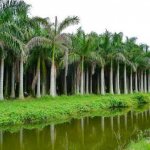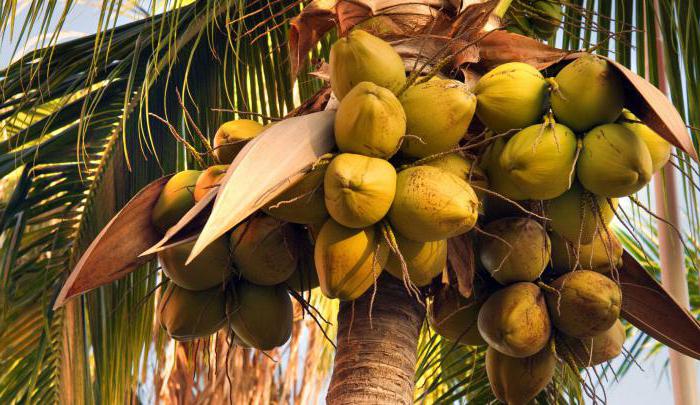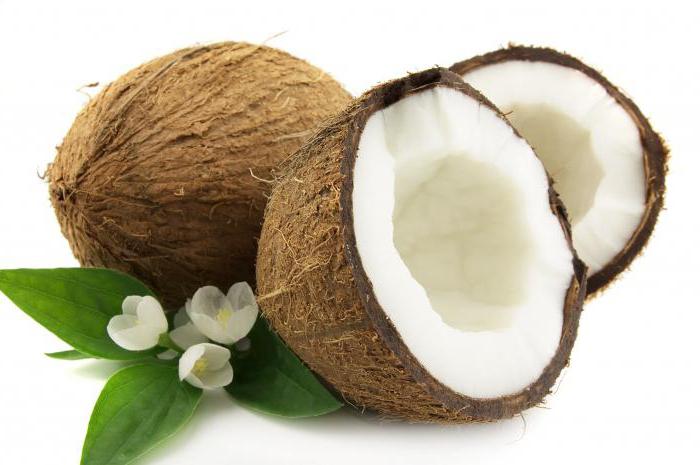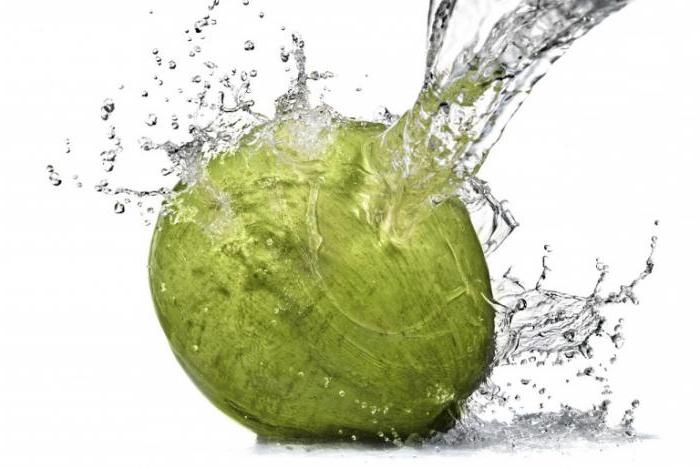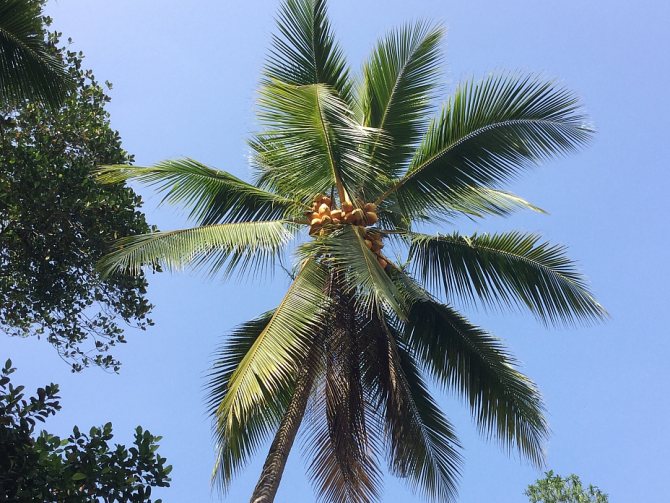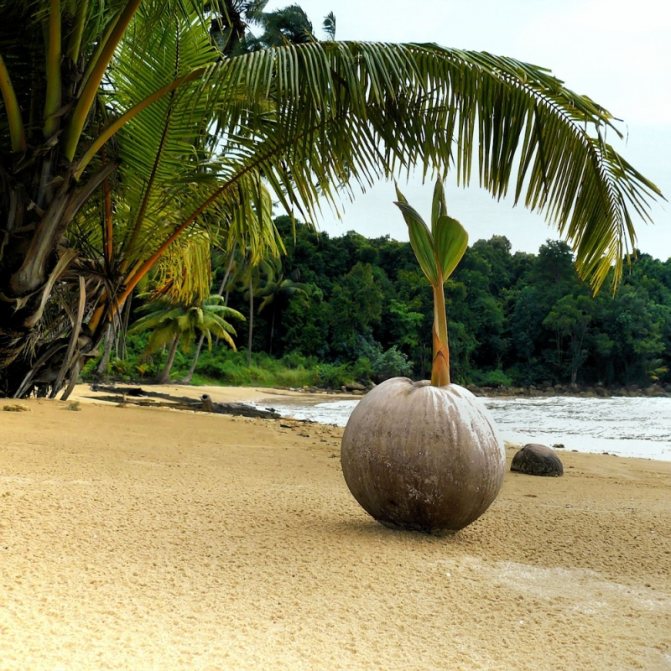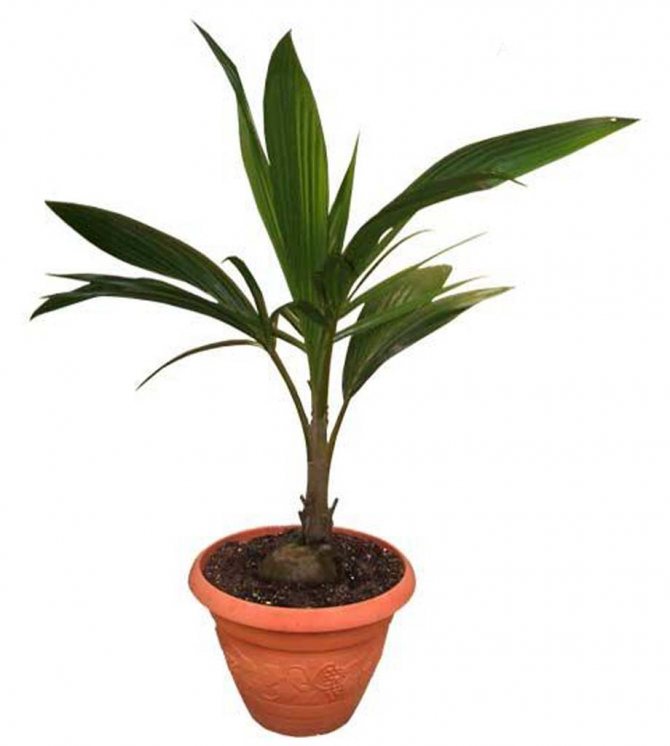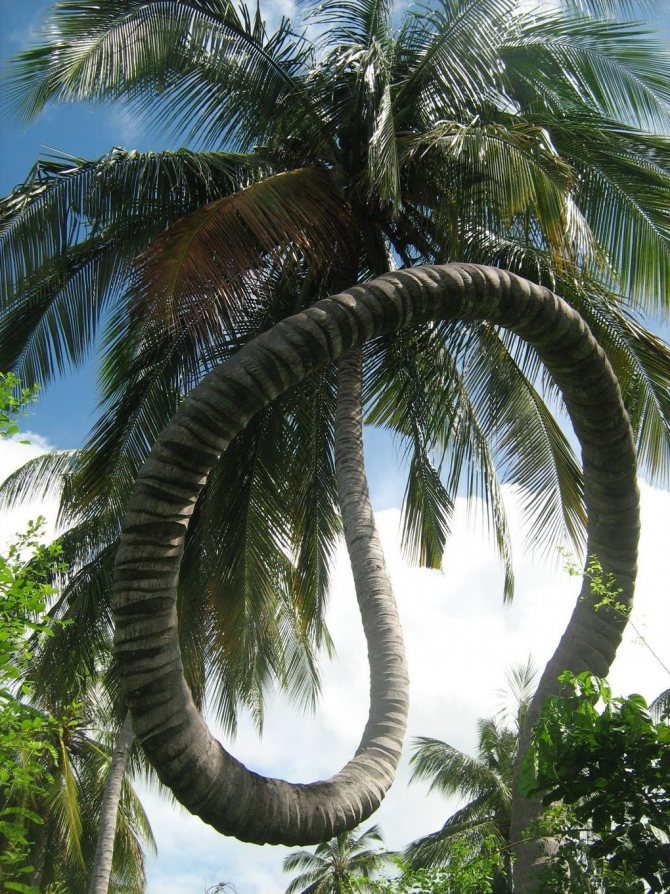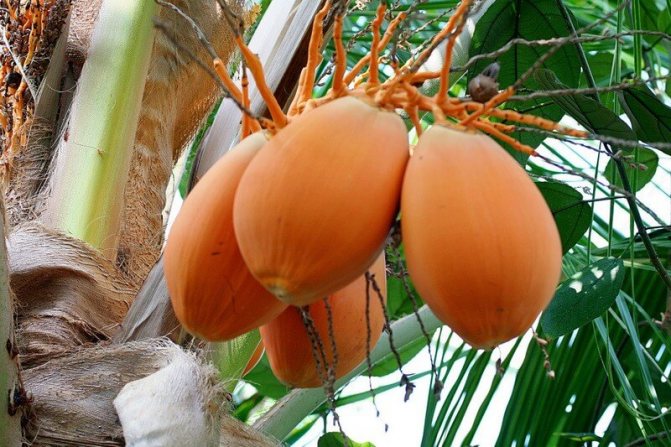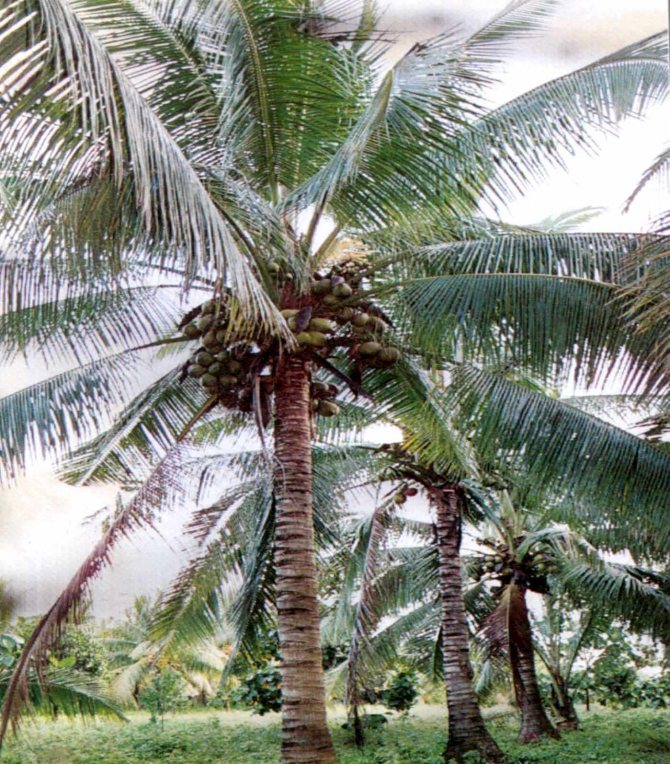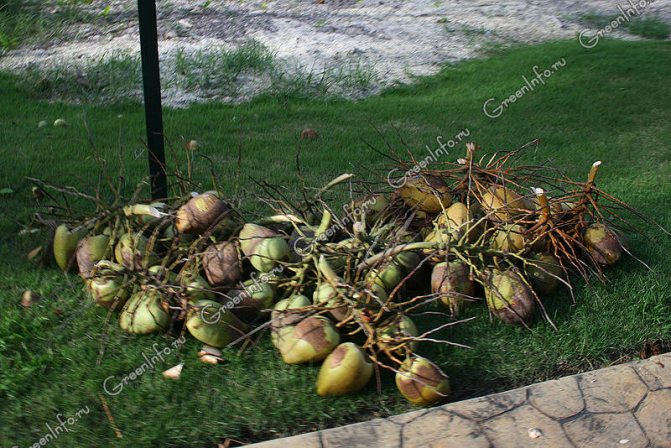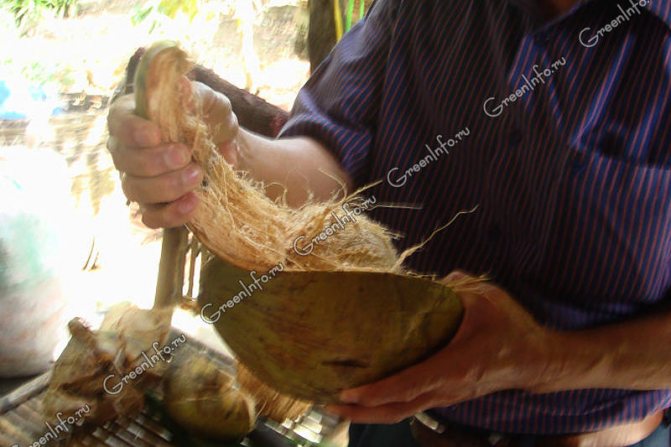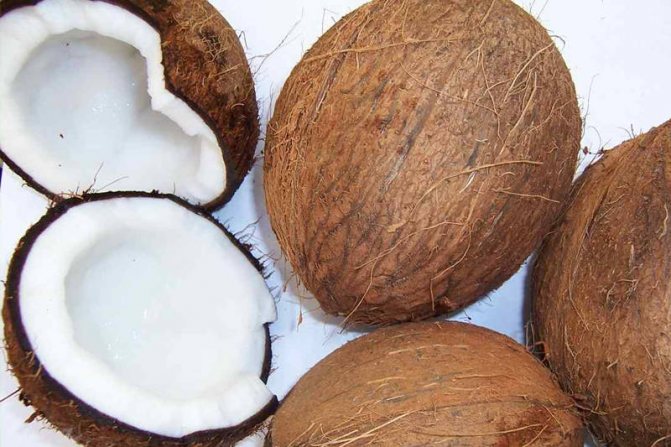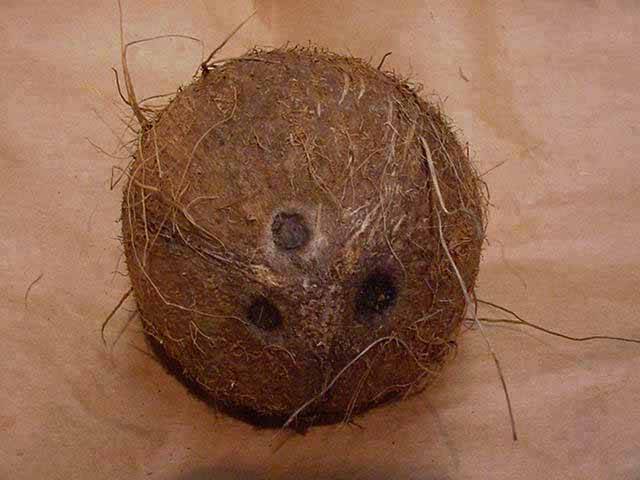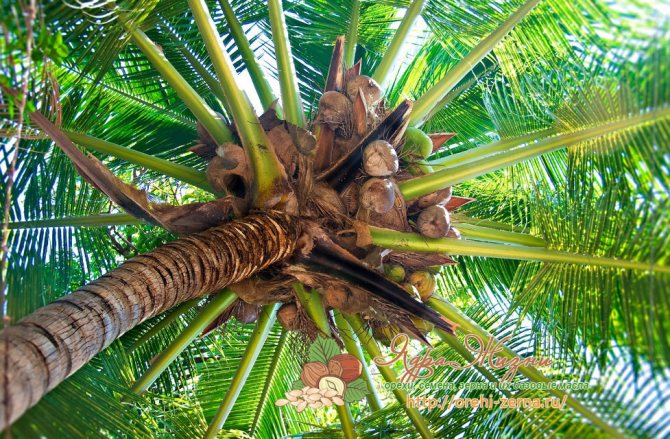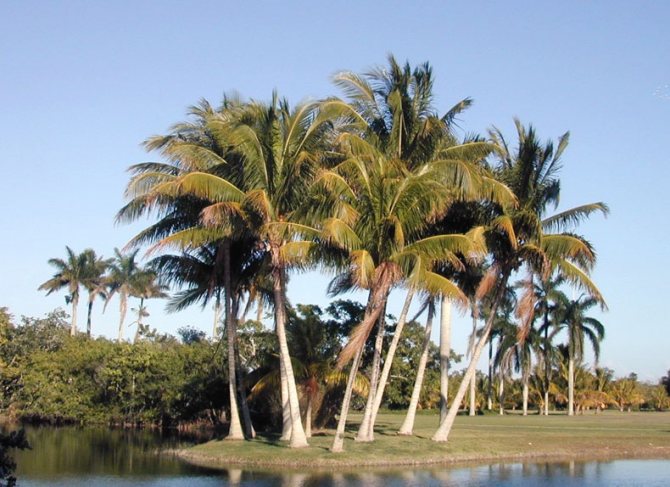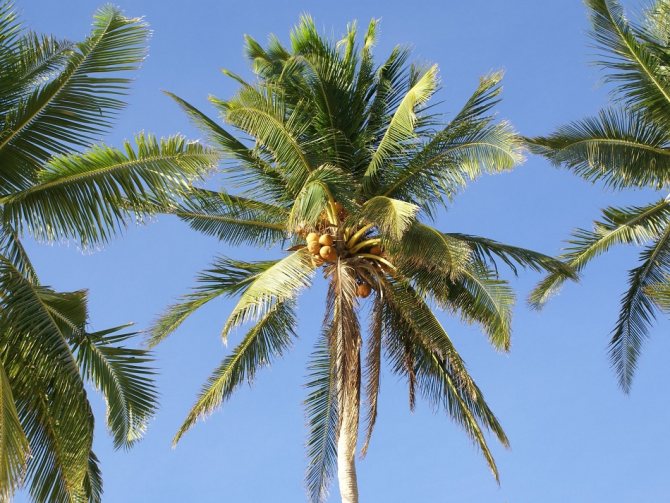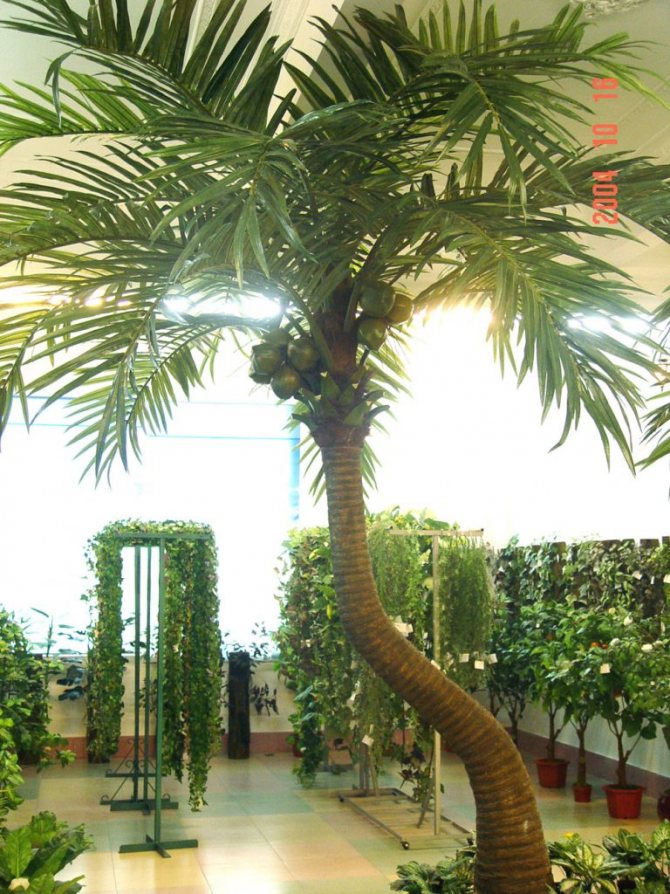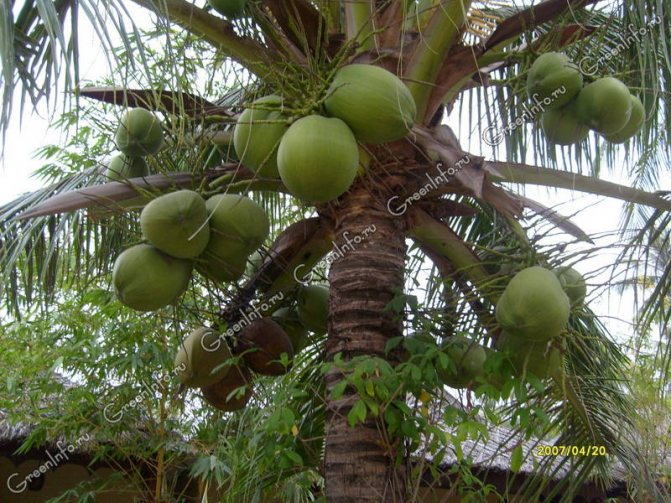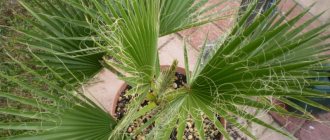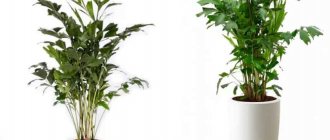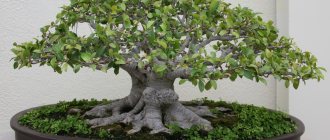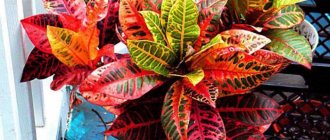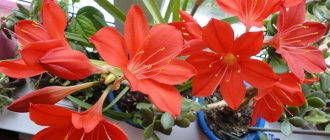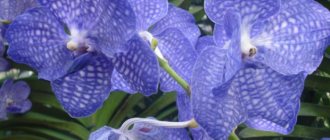The coconut tree (Cocos nucifera) belongs to the family Palm (Arecáceae, Pálmae, Palmáceae.
The coconut palm is one of the most beautiful and spectacular palms, but, unfortunately, it is one of the most difficult to care for, because it grows on the coast of the most beautiful beaches in the world. The historical homeland of this beauty is still not known, it simply cannot be established, since for many millions of years, thanks to the reproduction by means of nuts that can travel along the currents of the ocean, the palm tree was able to settle along all the tropical coasts of the world.
The name of the palm tree comes from the Portuguese word "coco", which means "monkey". This name is given to the palm because of the spots on the nut, which make the nut look like a monkey's face. The specific name of the palm tree nucífera comes from two Latin words —nux (“nut”) and ferre (“to bear”).
In an apartment environment, a palm tree does not feel comfortable without proper care, it is much better to grow it in greenhouses. With careful maintenance of the apartment conditions, this paradise palm tree can live for about 4-5 years, and then, it will begin to die due to lack of space, because in nature it reaches more than 30 meters in height.
There are dwarf varieties of the coconut palm bred by breeders, which in indoor conditions live much longer than their large counterparts.
If you come across a coconut tree, it will be an excellent decoration for any interior, there are not many options for its placement.
The coconut should not be separated from the palm tree, the young plant receives nutrients from it for the first 3 years.

Features of the structure of indoor coconut
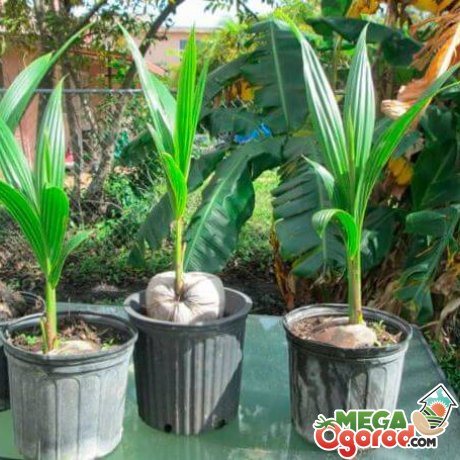

In nature, coconut palms reach up to thirty meters in height. In tubs, they can be less - six meters. Weddel and walnut palm are of interest as a decorative element.
The top of the glossy smooth trunk of the coconut tree is adorned with delicate feathery leaves. They have the ability to bend in an arc, looking down with their tips. Since the tropical plant is monoecious, both female and male flowers are located on it. They cross in a crossover fashion. In the nut-bearing coconut, the leaves are long and wide, arranged vertically.
The palm tree rarely bears fruit, if the appropriate conditions are created for it.
Coconuts can be edible and inedible, vary in color - brown, yellow, orange, green. The fruit of the drupe is covered with a hard shell, which consists of two layers - the pericarp, mesocarp. The third fibrous layer is called the endocarp. It is he who is used for the manufacture of various household items, clothing. Coconut is grown in spacious rooms, where it can grow up to seven years or more, delighting with bright greenery.
Roystowna palm
Royal Palm (Roystonea) - has a chic look corresponding to the name, standing out from its surroundings and landscape. The height of the tree can reach 40 m, the trunk is smooth gray, at its top there is a crown of huge feathery leaves up to 8 m long and 2 m wide.The plant is monoecious: male and female flowers are located on the same tree below the crown.
Roystouneya has 17 species, distributed in the southern states of the United States, in Central and South America, in the West Indies.The most popular species are the Cuban palm (Roystonea regia) and the royal vegetable palm, from which the edible, succulent apical buds, called "kale", are harvested.
Roystones are planted as a decorative decoration along boulevards and avenues in cities of the tropical region, along the edge of beaches, they are often used for decoration in landscape design.
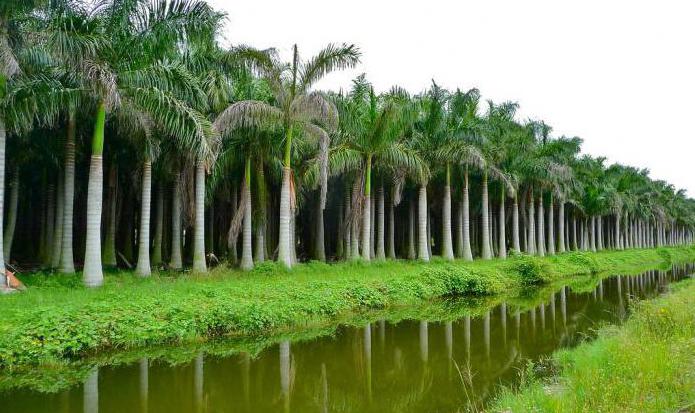

Everything that grows on the Roystonee palm tree is successfully used by humans: trunks are used in construction, leaves and fibers are used to make roofing and wickerwork, livestock eats fruits with pleasure, and palm oil is produced from seeds.
Reproduction methods of a tropical plant
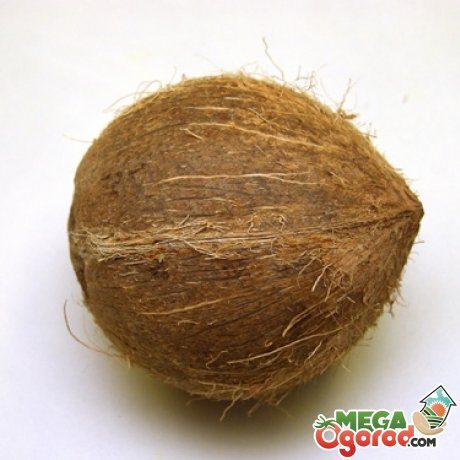

There is one way of propagation of the coconut palm - by seeds. The drupe is planted in the prepared soil, and after a while green shoots will appear.
The breeding sequence is as follows:
- The outer shell of the nut must be retained for planting.
- A soil consisting of half of peat and sand is poured into the prepared pot.
- Before immersing the nut in the soil, it is well moistened.
- Laying the coconut fruit horizontally, it is deepened, leaving one third above the surface.
The fruit is dipped in a container of warm water for three days.
Greenhouse conditions are created for the container with walnuts:
- The air temperature in the room should not drop beyond the plus 25 degrees, and the humidity should reach 80 percent.
- For rapid development, the plant needs regular watering.
- Moisten the emerging leaves and the air around with a weak solution of sea salt.
- Will speed up the process and placing the container with nuts in a plastic bag. But at the same time it is necessary to ventilate the soil daily.
Usually, after creating tropical conditions in six months, the fruit of the palm tree will sprout. To reproduce coconut, special knowledge is not required, only patience and care.
Growing problems:
- Leaf buns turn brown due to too dry indoor air. It is necessary to ventilate and spray the room as often as possible.
- The yellowing of the foliage is due to insufficient watering.
- Leaves wilt and darken if the room temperature is too low.
- Leaves curl if the plant is poured, or vice versa, the substrate is dry.
- Slow growth and lack of new leaves with insufficient fertilization or too tight a pot.
Views: 183
Terms and rules for planting a coconut tree
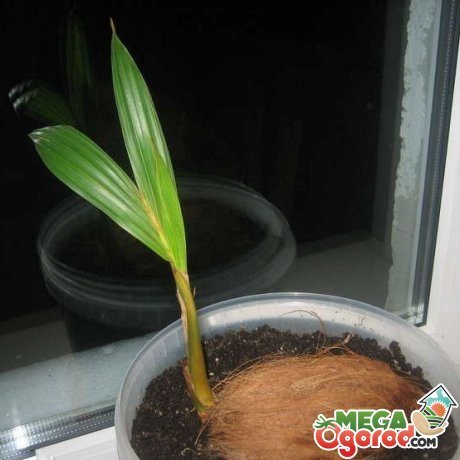

As soon as the coconut shoots have two or three leaves, then they can be transplanted to a permanent place. A pot or tub is chosen for a larger tropical tree so that the roots are free in it during constant growth. Fill with soil, consisting of two parts of humus with leaves, light loam, add one part of sand, peat mixture and a little charcoal. The acidity of the soil should be minimal.
Before placing the sprout in a new pot, the soil is well moistened.
An ideal place for growing a coconut palm is considered to be a greenhouse and a winter garden. After all, a tropical tree needs light, warmth and more moisture.
If the planting rules are followed, then the palm tree will begin to develop rapidly, reaching a height of three meters and more. Therefore, before thinking about growing a coconut in indoor conditions, it is necessary to calculate whether the tree will have enough space.
Useful and medicinal properties of coconut
Coconuts are very important in terms of trade and nutrition, in some parts of the world they are the main food of the population. Coconut is a nut whose health benefits are appreciated not only by food lovers, but also by scientists. No wonder - coconut pulp is rich in fiber, contains potassium, magnesium and phosphorus, as well as folic acid. However, the most important are the saturated fatty acids contained in the pulp of the coconut.
These are not the saturated fatty acids found in most animal products, that is, long chain triglycerides (LCTs), which contribute to increased cholesterol levels and the development of atherosclerosis. The saturated fatty acids found in coconut are medium chain triglycerides (MCT), which are metabolized in a completely different way. Due to the fact that their molecules are smaller, their metabolic process is faster. The presence of enzymes that are involved in the metabolism of LCT fats, that is, lipase and bile, is not required. MCT acids bypass the fat cells of the gastrointestinal tract, entering directly into the portal vein. Thanks to this, they are not stored as a spare material, but are a quickly available source of energy.
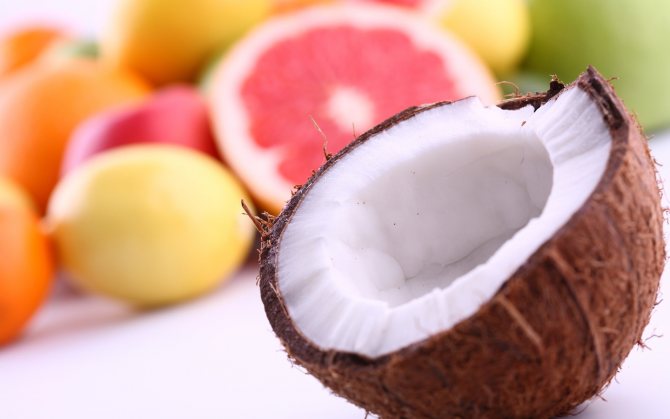

100 g of coconut contains a large amount of lauric acid (15.3 g), as well as 5.06 g of myristic acid. Coconut fruits are rich in natural amino acids (data per 100 g):
- isoleucine - 121 mg;
- leucine - 233 mg;
- lysine - 140 mg;
- phenylalanine - 158 mg;
- valine - 186 mg;
- arginine - 513 mg;
- alanine - 158 mg;
- aspartic acid - 308 mg;
- glutamic acid - 708 mg;
- glycine - 149 mg;
- proline - 130 mg;
- serine - 158 mg.
Ripe coconut kernels contain about 50% water, 25-35% fat, 4% protein and 8% sugar. They are very nutritious not only because of their high calorie content, but also because of the exceptional quality of the protein they contain.
Tips for caring for a tropical tree
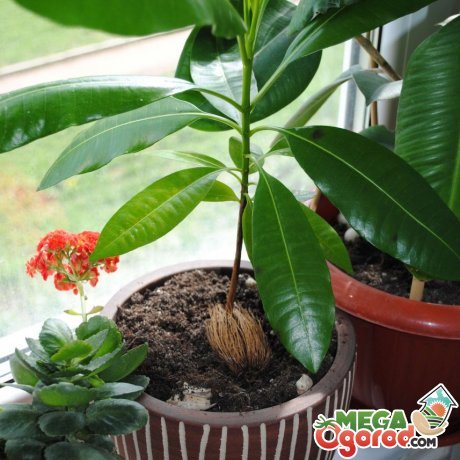

In particular, palm care includes the following parameters:
- The plant needs as much light as possible, but it should not burn the leaves. In the south-western, eastern part of the house, the sun gives scattered rays. There will be enough light for the palm tree. If you cannot find such corners in the house, then you will have to organize additional lighting. Artificial supplementary lighting is performed using fluorescent lamps.
- It is better to constantly humidify the air around the coconut tree by applying a spray from a spray bottle. It is important that the water droplets only fall on the leaves.
- The soil needs constant watering with water at room temperature. The liquid must be defended before watering.
- During the period of active growth, the tree is fed with organic fertilizers. This should be done at least once a month.
- The palm is transplanted every year until it reaches the age of 3-4 years. Then they try not to disturb the plant, renewing the topsoil in the container with humus. You can replant an adult tree when the pot has become small, the roots have filled the entire space. The method of transplanting is by transshipment, keeping a clod of earth on the roots.
- At the end of autumn, dry branches, leaves are cut off. If the leaf plates have darkened or changed color, then it is better to leave them as an additional supplier of nutrients.
- During the dormant period, the palm is watered less, rarely fed.
Coconut grows quickly in indoor conditions, if appropriate conditions are created for it, there is proper care.
Top dressing for walnut coconut
Fertilizers are an important factor in growing. There are many special products for palm trees on the market, but growers note that they do not give the desired effect. Based on many years of experience, the ideal top dressing has been determined - a mixture of fertilizers for citrus plants and bonsai.
The composition is introduced during the period of active growth, that is, almost all the time of life at home. If you refuse to feed, the risk of losing the attractive appearance of the plant increases, so it is better not to risk it. Some growers recommend limiting the application of fertilizers in early spring, mid-autumn and summer, but in this case, concentrated formulations are needed, which often have a detrimental effect on the condition of the plant.
Plant diseases and pests, how to overcome them
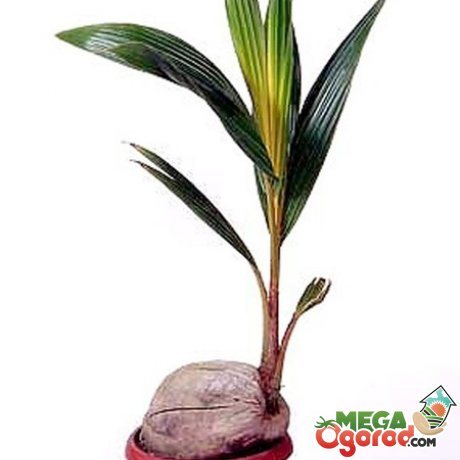

Among the diseases of the coconut tree, fungal pathologies are more common.Humid indoor air promotes the development of pathogenic microorganisms. The disease can be detected by the presence of spots on the leaves, root decay. The plant begins to wither, stops growing. And here spraying with fungicidal agents will cope with pathological symptoms: Fundazol, Topaz. The frequency of processing a sick tree is once every two weeks. It will save you from the disease three times during the procedure.
To prevent the spread of fungi, they moderate the humidity of the air, remove the tub with a flower from direct sunlight. If the roots are damaged by rot, be sure to transplant the coconut palm into another container. During the procedure, diseased roots, stems, leaves are cut off, and the plant is placed for some time in a Kuprozan solution.
Among the parasites that inhabit palms, one can distinguish spider mites, mealybugs, thrips.
Having found the first signs of a pest attack, the plants are sprayed with insecticidal preparations. Fitoverm, Vertimek are among them. The trees are treated weekly until the parasites are completely destroyed. Pests and diseases attack a palm tree, if the care of an indoor flower is carried out incorrectly, its living conditions are unfavorable.
Read also: Quince application in traditional medicine
More information can be found in the video:
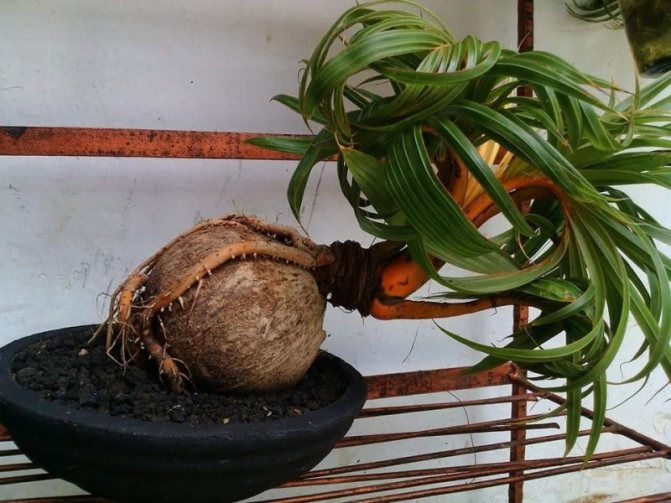

Tropical plants have long ceased to be a rarity in our interiors. And we are talking not only about flowers or vines, but also about real trees. For example, a coconut tree at home can become the main decoration of a design. Everyone can grow it on their own, the main thing is to know the features of germination, follow the rules of planting and care, and understand that not every nut sold in a grocery store can produce a beautiful plant.
How to grow a coconut tree yourself?
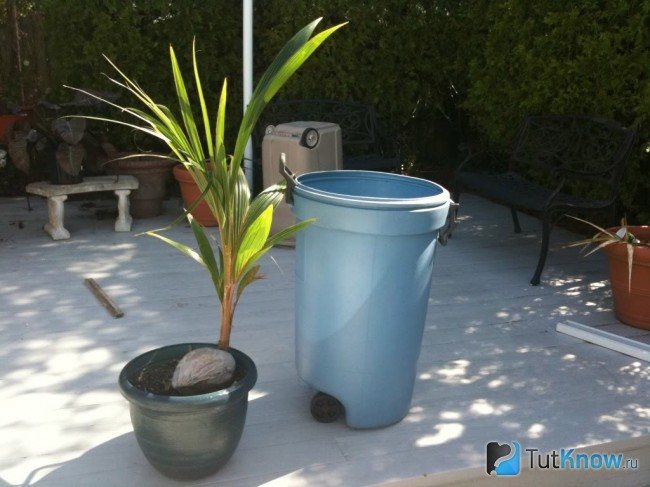

You can grow a coconut tree yourself at home. This is done with a nut, the fruit of a coconut, which should be kept in a greenhouse or other warm place at a temperature of about 30 degrees. It is necessary to keep it until it sprouts, after that, place it in a pot of earth. As a rule, the germination process takes about 6 months. When a palm tree grows a few centimeters, it is important to provide optimal conditions for its growth:
- you need to grow it at a temperature of 23-26 degrees, since the coconut tree loves heat very much. In winter, the temperature should not be lower than 17 degrees, because the plant may die;
the substrate for the coconut tree should be soft and consist of half of peat and humus. When planting a nut in the ground, it is very important not to completely immerse it in the soil, only its lower part should be in the ground;
the palm tree should be placed in a bright place, but at the same time protect it from the sun's rays. Also, if possible, it can be additionally illuminated with special devices. This plant reacts quite well to light;
special attention should be paid to the humidity where the palm tree is located. Since it mainly lives in the tropics, it needs humidified air (about 70 - 80%). Therefore, if possible, spray it with water at least every other day. Make sure that water does not fall on the nut, otherwise the plant will begin to rot and disappear;
- Since the coconut takes a very long time to grow, it needs to be fed. For this, it is best to use only organic fertilizers. This should be done no more than once a month. For older plants, it is advisable to start feeding in the spring and do this throughout the summer. It is recommended to leave the coconut dormant in winter, as the growth process itself is reduced.
What is a home coconut tree?
The coconut palm, or Cocos nucifera, belongs to the Coconut genus, the Palm family and is considered one of the most abundant plants on planet Earth. Her homeland is Malaysia.Under natural conditions, the coconut of Nucifer grows up to 30 meters in height, the leaves of the tree reach 6 meters in length, and the life span can exceed 100 years. Indoor coconut palm is more modest in size and grows slowly in the apartment. It has long, sparse leaves grouped in pairs, which form a vayu directly from the nut. The fruit, half buried in the ground, is in the planting pot.
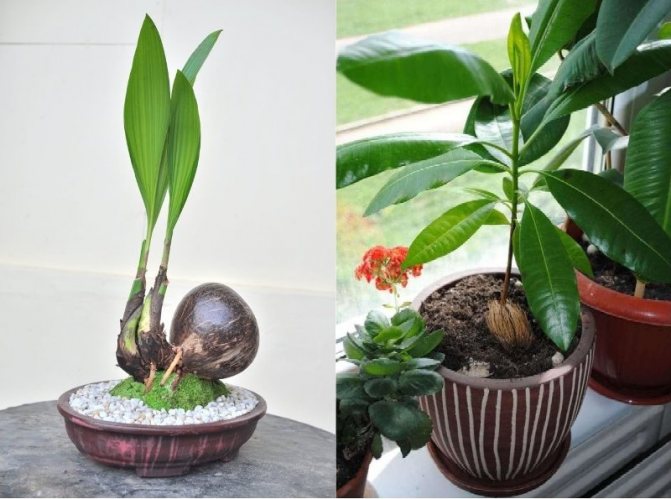

Indoor coconut Nucifer
Indoor coconut palms look very attractive: the contrast between a half-buried nut, from which at first a slender and small tree rises, and then an increasingly graceful and interesting tree, adds decorativeness to it.
For cultivation at home from all varieties of this exotic tree, the following are mainly used:
A tropical beauty is grown from a bone. Rather, from a coconut - a spherical or oval drupe covered with a thin but strong shell on the outside and a hard shell on the inside. Its length can reach 30 centimeters, and its weight can exceed 2 kilograms. In addition, the seeds of the coconut palm contain a fleshy layer, which is 1.2 millimeters thick, and coconut water. When the fruit ripens, it turns into milk and gradually hardens.
If we talk about how to grow a coconut at home, then most often a young palm tree is purchased ready-made, in a pot, since the process of its germination is quite long. Not everyone has the patience for him. And the main focus should be on care. In this case, it is especially important to protect the part of the coconut located above the soil surface from rotting. To do this, you must ensure that moisture does not get on it during watering or spraying.
Coconut oil
Coconut oil rich in vitamin E, which improves reproductive function. Coconut milk is 40% composed of coconut oil, which is the most valuable dietary product. Its main asset is the unique lauric acid, which, in addition to coconut, is also found in palm oil and human breast milk. Lauric acid helps to protect the body from infections and viruses and normalizes blood cholesterol levels. Also, coconut oil normalizes thyroid function.
Coconut oil very quickly absorbed. It reduces the risk of atherosclerosis and heart disease, cancer and degenerative processes. It has long been noticed that coconut oil has a long shelf life, even when opened. This is due to its bactericidal properties. Therefore, it increases resistance to bacterial, viral and fungal infections.
Coconut oil is good for the skin of the face and body, it smoothes the skin, maintains the elasticity and firmness of the skin, and improves skin tone.
You can read more about coconut oil here:
- Coconut oil. Beauty secrets.
- Coconut oil. Composition, properties, application.
Reproduction of coconut: germination and preparation for planting
Coconut palms reproduce by seed (seed) and by shoots. The second method of propagation of a coconut is very rare, when an adult palm gives rise to a daughter shoot. The main and almost the only way to reproduce at home is to grow a palm tree from an ordinary coconut (seed method).
You can purchase coconut seeds (suitable fruit) at the store. The fruit must be unprocessed and the outer shell must not be damaged. Only a mature coconut full of liquid is able to germinate. Its presence can be easily identified by the characteristic gurgle, which is clearly audible if the fruit is shaken.
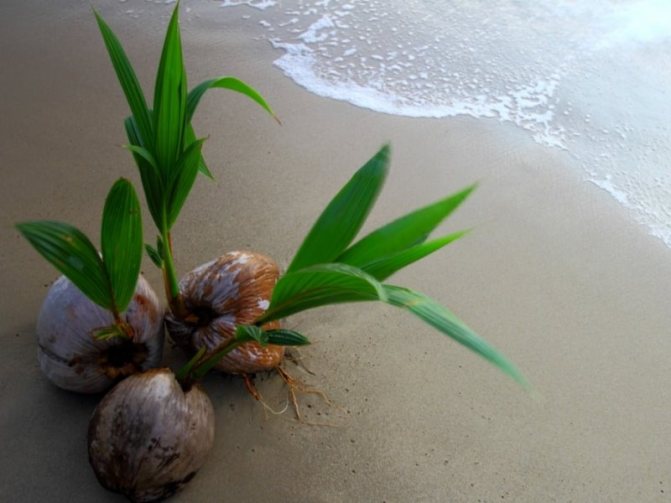

For planting, only a walnut covered with a shell is suitable. Peeled coconuts are sold in stores. The top layers - exocarp and coir are always removed before the product reaches the counter.This valuable raw material is used in industry.
Before planting a seed-fruit in a permanent place, it must be germinated. There are 3 holes in the coconut shell for planting and germination - these are seedling pores. They look like small depressions in the shell. Only one of them will be active, and the other two will overgrow.
To germinate a coconut, it is pre-soaked for 2-3 days in warm water. Then they are placed on a wet substrate (peat or sand) in a greenhouse or container, buried in half and kept at a temperature of 24-25 ° C. This temperature is closest to natural and optimal for germination. The nut should be placed horizontally, so that the seed pores are on the side.
To accelerate the germination process, it is recommended to keep the substrate moist. The nut itself can be periodically sprayed with warm, slightly salted water. Use sea salt. The container in which the nut germinates can be wrapped in a plastic bag in order to create a greenhouse effect inside (the required temperature and humidity) and do not forget to open it daily for ventilation, otherwise the fruit may become moldy. Thus, they imitate the conditions natural for the germination of a coconut in its habitat.
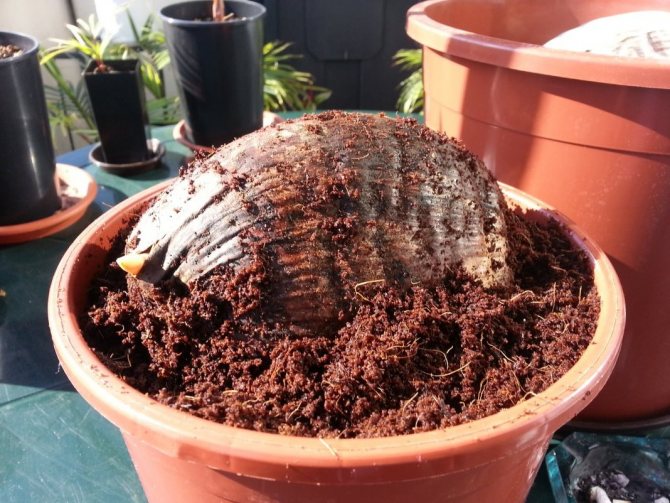

If everything is done correctly, after a certain time the nut will give roots, and green sprouts will appear from the seed. A fresh, ripe nut takes 1 to 2 months to germinate. But in principle, this process can take six months. If after 5-6 months the sprouts did not appear, it means that the fruit was immature and it is pointless to wait further for it to germinate.
The benefits of coconut
Coconut has medicinal and medicinal properties, contains vitamins B, E and C, as well as mineral salts necessary for the human body - sodium, calcium, iron, potassium, up to 5% glucose, fructose and sucrose.
Coconut is useful for improving vision, restoring strength, has a reputation as a powerful aphrodisiac and harmonizes the human reproductive system. Coconut products are used to treat skin and hair as they have regenerating properties.
The content of nutrients in coconut:
100 grams of coconut juice contains: Protein - 3.9 g Fat - 33.9 g Energy value - 384 kcal Phosphorus - 200 mg Calcium - 28 mg Potassium - 257 mg Sodium - 257 mg Iron - 2.3 mg Nicotinic acid - 0 , 4 mg Thiamin - 0.11 mg Vitamin B2 - 0.08 mg Vitamin C - 16.8 mg
How to plant a coconut in a pot
After the shoots of the coconut palm tree with the first 2-3 leaves appear, the sprouted fruit can be transplanted to a permanent place.
Before planting a coconut tree in the soil, you need to choose the “right” pot. It should be wide, twice the volume of a nut. There must be drain holes in the bottom so that excess water can flow out. Accordingly, a pallet is also needed. If there are no such holes, you will have to make them yourself.
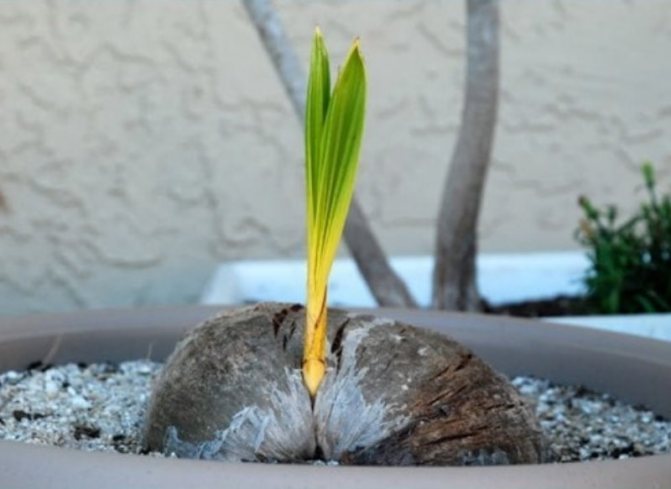

Sprouting a coconut requires patience and special conditions. If there is no desire to do this, then you can always purchase a young plant of an ornamental variety in the garden center.
A drainage layer is laid at the bottom of the pot (shards or expanded clay are suitable), and a substrate is poured on top. The soil seven should be loose and well-drained and not acidic. The best option is special soil for indoor plants interspersed with sand or light loam, humus, peat mixture, sand and charcoal in a ratio of 2: 2: 1: 1: 1. The soil for tropical plants should not be acidic.
Before planting a sprouted coconut, the soil must be moistened. The sprouted nut is buried halfway into the ground, in the same position and at the same depth as during germination. That is, only the lower part is covered with the substrate, and the upper part remains on its surface. It is not necessary to separate the seedling from the nut. A young palm uses its stored nutrient reserves during the first 3 years of growth.
As the tree grows and develops, its lower branches begin to die off. New ones are formed at the top of the main stem. So over time, the formation of the trunk occurs. It is smooth, straight, and can tilt slightly to the side. The trunk is surrounded by scars remaining from fallen leaves.
Read also: Border of a rectangular section 2 km section length
For a tropical tree, you should choose a suitable place in the house. The best option is a winter garden or a greenhouse. But the plant can feel comfortable on the windowsill, especially if it faces the south side. It is important that it receives enough light and moisture and does not suffer from the cold.
Plant transplant
Young plants are transplanted annually for better growth. They do this in the middle of spring. The new container should be only a couple of centimeters or 10% larger than the previous one.
The plant is removed from a tub with a lump of earth, only damaged roots are removed. The palm is planted at the same depth as before. The soil mixture and drainage layer should be the same as in the old location. If the roots are bare or damaged during transplantation, then for better survival in a new place, part of the leaves is cut off from the palm tree.
Perennials that have reached 3-4 years of age are transplanted only if necessary. A mature palm tree does not like it when it is disturbed and its roots are damaged. In response, she may stop growing.
Reference. It is interesting to know how long a coconut tree grows. Under natural conditions, tall varieties develop up to 80 years, and dwarf ones - up to 40 years. In residential premises, with good care, they continue to grow for 2-3 decades.


A grown palm tree needs to be replanted every year.
Potted coconut tree care
To decorate the interior of the house with a beautiful exotic guest, you will have to surround her with tireless care, which is not easy. Caring for a coconut tree comes down to a few basic aspects.
Lighting
A coconut tree needs bright and long-lasting light all year round. Therefore, it is recommended to keep it on the southern windowsill, and when the daylight hours become shorter, use additional lighting. If the light falls on the coconut tree from only one angle, its crown will form asymmetrically. To avoid this, the tub with the plant should be turned 2 times a month.
The best lighting is diffused. Direct rays of the sun can burn a young palm tree, therefore, in the middle of the day, direct sunlight should be avoided and, although the shade of a coconut is contraindicated, partial shade is quite acceptable. As they grow older, the tropical guest becomes more tolerant of the sustained effects of the hot sun, and in this regard, caring for her becomes easier.
Indoor air temperature
A visitor from tropical latitudes feels comfortable only in warmth. The optimum air temperature in the room where it grows varies between +23 - + 280 C and should not fall below this mark. In this case, the palm tree needs an influx of fresh air, so it is important to provide it with regular ventilation.
If the air temperature drops to +16 ° C and below, the growth of the palm tree will stop. The plant will withstand a short-term drop to 0 degrees, but at sub-zero temperatures it is guaranteed to die.
Watering
In the process of caring for a coconut, it is important to strictly adhere to the watering regime. Short-term or long-term drought is just as damaging to coconut as excessive moisture.
The frequency of watering depends on the season:
- from mid-spring to late summer, it is important to prevent the soil from drying out. The soil in the pot at this time should always be moistened;
- from the beginning of autumn to the end of winter, the plant is watered as the soil dries up.
It is important that the air in the room is always humid. The best way to solve this problem would be drip irrigation, as well as the installation of a special humidifier. You can also prepare a sea salt solution and humidify the air with it periodically.For any water procedures, you can use only soft, settled water at room temperature.
Top dressing
Excessive feeding of the coconut palm is not required, but they should not be neglected either. With a lack of nutrients, the coconut loses its decorative appearance.
You can choose a feeding scheme from two options:
- Once a year, at the beginning of spring, place granulated feed into the substrate. During the year, it will slowly dissolve, giving the nutrients necessary for the palm tree to the soil.
- From the beginning of April to the end of August, with a frequency of 1 time in 3 weeks, feed the plant with a specialized solution for palm trees.
Trimming
It is not necessary to artificially form a crown and cut off the leaves of a coconut palm. The need for cutting arises only if the leaf is completely dry or broken. Yellowing, drying out, changing color leaves do not need to be removed. Until they are completely dry, the plant takes nutrients from them. To maintain decorativeness, you can cut off the dried ends if they are brown, and it is better to leave the sheet itself.
The formation of the crown of the palm tree is not required, but it is necessary to cleanse the plant from dried leaves. At the same time, it is important to remove only completely dry ones, without touching those that are just beginning to change color.
Comfortable temperature
Coconut is not only the most light-loving, but also the biggest fan of warmth. Throughout the year, it requires heat - from 23 degrees and above. It can survive short-term drops in temperature, but not less than 17 degrees.
This palm tree needs access to fresh air. The issue is solved by regular ventilation, but the organization of the process is a separate difficulty, because the slightest draft can slow down the growth of a plant, affect its appearance and even kill. A sharp drop in temperature and humidity is also destructive - this makes winter ventilation almost impossible.
How to transplant a coconut tree at home
Periodically, the coke palm is transplanted into a larger pot. There may be several reasons to transplant a tropical beauty. And each of them has its own characteristics.
As you grow
You can determine that the plant has become cramped in the pot by the following signs:
- The palm tree stops growing.
- Water stagnates in a tub on the surface of the substrate.
- The roots stick out.
Young plants are usually replanted once a year, in April. By this time, the coconut, as a rule, has fully adapted to the new growing conditions. At the same time, the earth around the roots and the shell are preserved. Adult palms that have dropped a nut require replanting once every 2-3 years.
When the age of the palm tree becomes 5-6 years old, the transplants are stopped, and instead of them, high-quality humus is added in a tub on the surface of the soil.
The new pot should exceed the old one in volume by at least 5-6 centimeters (15-20% more than the previous one in volume). The transplantation procedure is standard: the tree, along with a lump of old earth, is transferred to another container and the free volume is filled with new earth. So that the coconut does not suffer, you need to do this carefully, not to damage the trunk and roots. When transferring a coconut tree from one pot to another, it is also important to ensure that the nut does not go deeper into the soil by more than half.
If the plant is purchased already grown in a pot, its transplant at home is planned for the coming spring. In the future, it can be transplanted according to the standard scheme - every 2 years.
For replacing soil
If the substrate has deteriorated or has become too old, which is, in general, the same thing, the palm also needs to be replanted. It is possible to determine the improper condition of the soil by a white coating on the surface, an unpleasant odor, and poor water absorption.
In this case, the pot is of the same size. You can also leave the old pot, after washing it and treating it with an antifungal solution.
If the plant rots
It looks like this: the soil in the pot is wet, even if it is not watered, the trunk looses easily; the soil is constantly wet, an unpleasant odor emanates from the palm tree, and its trunk shakes from a light touch.
The first thing to do in this case is to cut off decaying roots. With such a transplant, you can also not change the pot or take another container of the same size.
How to open a coconut and extract the pulp
Having bought a coconut, of course, you need to open it. To do this, following a certain order of actions, is quite simple:
- there are three small holes in the place of germination of coconut seeds, with the help of a corkscrew or a sharp knife, you need to punch two of them, then pour the coconut milk into a bowl;
- to make it easier to open the nut, you can put it in a warm oven for a few minutes. After cooling, place it on a board and hit with a meat hammer at a distance of one third from the eyes to the opposite end;
- while turning the coconut, continue to strike until the fruit cracks;
- in order to separate the pulp from the shell, you need to insert a knife blade between them and gently pry;
- the coconut is ready!
Milk can be drunk straight away or mixed with alcohol or other juices as a drink. You can also use it to prepare dishes with a tropical finish. For the first time, real coconut juice, it is better to drink in small sips, because the real taste of coconut differs significantly from those synthetic ones that many have become accustomed to. The pulp is eaten in strips or dried and crushed into shavings. It is used mainly in cooking, as the main accent of a dish or decoration.


Diseases and pests of homemade coconut
Coconuts at home most often suffer from various types of rot, mealybugs, as well as spider mites and scale insects. When cultivation techniques are followed, diseases and pests rarely infest coconuts. As a rule, improper watering serves as a catalyst for their development.
There are few serious diseases in coconut trees, these are:
- Phytoplasmic infection. This is an incurable disease. It can be diagnosed by the appearance of the crown - it turns yellow from bottom to top. It will not be possible to save the palm tree, it will have to be burned.
- Pink and black rot (attack by spores). The tree becomes weak, leaves and shoots begin to rot. If the process is running, the trunk also rots. The putrefactive masses are dark brown, black or pink, depending on the type of infection.
The plant is treated with fungicides: treatment 1 time in 7 days, until complete recovery.
Read also: Can beans during pregnancy
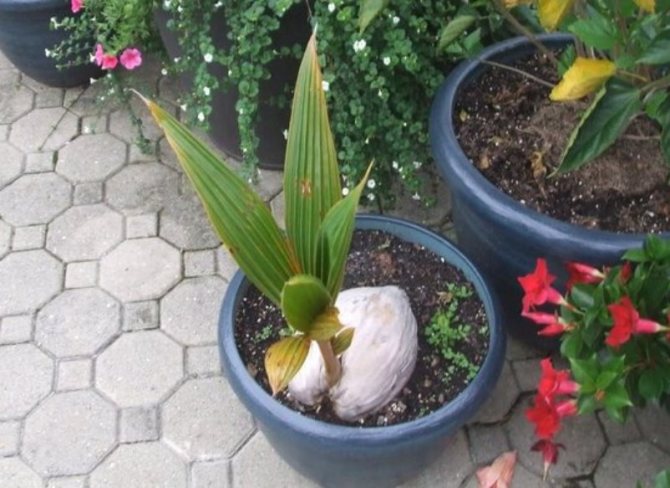

If the coconut tree is maintained correctly, problems rarely occur, but any irregularities in humidity and temperature become catalysts for the development of diseases and the reproduction of pests.
Homemade coconut owners may also face the following problems:
- The leaves are withering. This could be because the ambient temperature is too low.
- The leaves begin to turn yellow and dry. To prevent the coconut from turning yellow, it is important to observe the watering regime.
- The tree does not grow. Palm growth can stop due to improper fertilization or too little pot size.
- Rolling leaves. Observed with excess or deficiency of moisture.
Growing a coconut tree at home is not easy, but incredibly exciting. Tropical beauty is a demanding and capricious plant. But if you strictly follow the rules of care, she will settle in your apartment for a long time, and even in the coldest winters you will be next to her, as if on a warm sea coast.
The coconut tree (Cocos nucifera) belongs to the family Palm (Arecáceae, Pálmae, Palmáceae).
The coconut palm is one of the most beautiful and spectacular palms, but, unfortunately, it is one of the most difficult to care for, because it grows on the coast of the most beautiful beaches in the world.The historical homeland of this beauty is still not known, it simply cannot be established, since for many millions of years, thanks to the reproduction by means of nuts that can travel along the currents of the ocean, the palm tree was able to settle along all the tropical coasts of the world.
The name of the palm tree comes from the Portuguese word "coco", which means "monkey". This name is given to the palm because of the spots on the nut, which make the nut look like a monkey's face. The specific name of the palm tree nucífera comes from two Latin words —nux (“nut”) and ferre (“to bear”).
In an apartment environment, a palm tree does not feel comfortable without proper care, it is much better to grow it in greenhouses. With careful maintenance of the apartment conditions, this paradise palm tree can live for about 4-5 years, and then, it will begin to die due to lack of space, because in nature it reaches more than 30 meters in height.
There are dwarf varieties of the coconut palm bred by breeders, which in indoor conditions live much longer than their large counterparts.
If you come across a coconut tree, it will be an excellent decoration for any interior, there are not many options for its placement.
The coconut should not be separated from the palm tree, the young plant receives nutrients from it for the first 3 years.


Types of palm plants
Palm is a southern woody plant that grows exclusively in tropical and subtropical climates. The Palm family belongs to flowering plants and has about 185 genera and 3400 species. There are especially many of these plants in the zones of Southeast Asia and in the tropical countries of South America.
In colder regions, palm trees can be seen in the Mediterranean and North Africa, Crete, Japan and China, northern Australia, etc.


Palm trees can be found in completely different places, from the seaside to the slopes of the highlands, near swamps and forests, as well as in hot oases in the desert. However, most of all they prefer humid and shady areas with a tropical climate, forming continuous thickets. Palm trees are also widespread in the African savannas, where they can easily withstand drought and hot winds.
About caring for a coconut tree at home
Temperature: The coconut palm is one of the most thermophilic and can hardly tolerate even short-term temperature fluctuations. Temperatures should be consistently high, 22-25 ° C throughout the year. In winter, make sure that the temperature does not drop below 18 ° C. The palm tree needs constant access to fresh air, it is necessary to regularly ventilate the room, but remember that the palm tree does not like drafts, so this should be done as carefully as possible.
Lighting: The palm tree needs a lot of light throughout the year, which is one of the main difficulties in its cultivation. A young coconut must be protected from direct sunlight, but an adult palm tree can already withstand them calmly. The best place for a coconut tree would be a curtained south loggia or balcony. In winter, the palm tree must be kept on the south window, but even the south window during this period does not completely provide it with lighting and additional lighting is required with special photo lamps, since the coconut needs a long day of light all the time.
Watering: The coconut tree needs a consistently moist substrate all year round. In the summer, watering should be plentiful, about 3 times a week, you can not run stagnant water in the pot. Between waterings, the topsoil can dry out only by 1 cm. In winter, watering is reduced to 1 time per week, but it is impossible to bring the soil to dryness. The state of the substrate must be constantly monitored, since the slightest deviations in watering from the norm can lead to disastrous consequences.
Air humidity: The plant is very demanding on air humidity.In summer and winter, palm leaves must be sprayed daily with soft, settled water more than 5 times a day. The more often this procedure is performed, the better the coconut will feel. The humidity index for this palm tree should be above 70%, only then the palm tree will look as decorative as possible and live longer. For a coconut tree, it is vital to install pallets with wet gravel or expanded clay, automatic air humidifiers, this will greatly facilitate the care of this exotic.
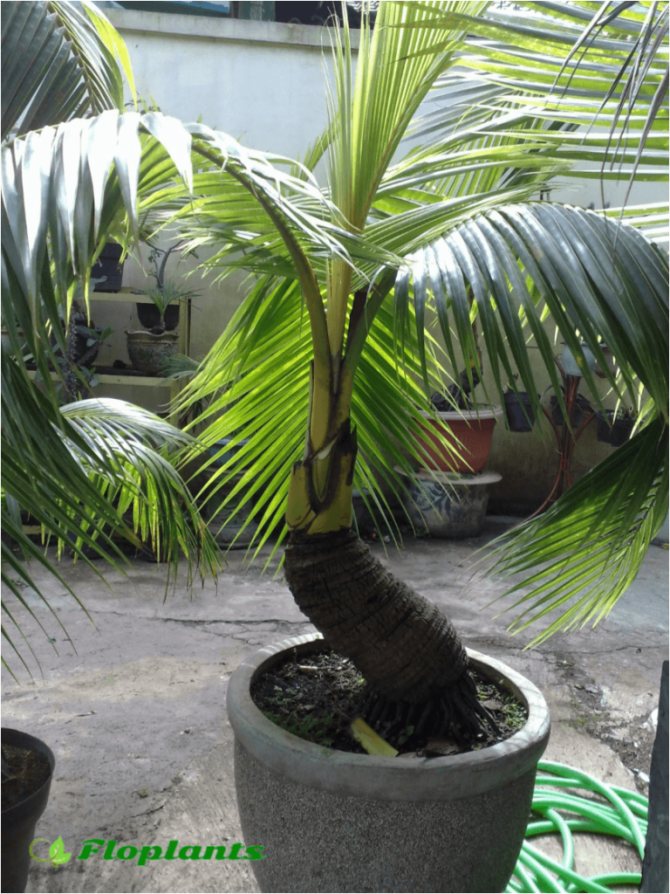

Crown formation: The coconut palm does not need to be formed, but from time to time it is necessary to carry out procedures aimed at maintaining its decorative effect - pruning dry leaves. Please note that only completely dry leaves that are yellowed or half dried are not subject to pruning.
Flowering coconut tree: It is impossible to achieve flowering of a coconut tree in indoor maintenance. In nature, if a coconut tree begins to bloom, it blooms throughout its life.
Fertilizers: Fertilize a coconut tree every 2 weeks throughout the summer period, in the autumn-winter period, depending on the conditions of maintenance, fertilizer is applied once a month. It is best to use special complexes for citrus plants and bonsai, they have shown the best results.
The soil: Coconut palms are grown in a special palm substrate. At the bottom of the container, there must be a thick drainage layer, more than 4 cm.
Transfer: The palm tree does not need frequent transplants; it reacts hard to changing containers. Coconut is transplanted only by transshipment, carefully handling it, in order to avoid even the slightest damage to the roots, which can have a detrimental effect on the plant. The container for the palm tree is taken much more than the previous one, by 5-7 cm, in order to carry out the transplant as mono less often. A young coconut tree with a nut is transplanted only once every 2 years, older specimens 1 every 4-6 years. When the transplant is not carried out, the top layer of the substrate must be changed. During transplanting, it is necessary to carefully monitor the level of deepening, it should be the same as before, not deeper than half of the nut, the palm tree responds better to a higher planting than deepening. If the palm tree is already an adult, has dropped the nut, they still try to keep the same level of deepening.
If you just bought a coconut tree, you must definitely give it at least a week to adapt to the new conditions of detention, and only after that the transplant is carried out.
Reproduction: Only with the help of fruits. You can read about how to grow a coconut indoors in a separate publication. How to grow a coconut palm tree at home.
Pests: The coconut tree can be damaged scale insects, spider mites, mealybugs, aphids.
What is the name and what is useful for the pulp of coconut
The solid endosperm of coconut, dried in the sun or in an oven, is called copra. Copra contains only 7% water, while 60-70% fat, 14% sugar and 7% protein. It is crushed into flakes, shavings or coconut flour, which are of great use in bakery and confectionery.
As you know, a person cannot limit himself to vegetable protein, but he must consume at least a small amount of animal protein daily. So, coconut protein is able to completely replace animal proteins in the diet, and because of this, coconut is an especially important raw material for the food industry in a vegetarian diet.
From copra, a very valuable product is obtained, used in the food industry and in technology, because of its consistency it has a name - coconut oil. It, at temperatures below 20-26 ° C, has a constant consistency, reminiscent of butter, and at higher temperatures it is liquid. Good, fresh coconut oil is pure white, has a light taste and a delicate, peculiar smell.
In countries where the coconut palm is massively grown, especially in Indonesia, coconut flakes or just grated fresh coconut kernels are added to all types of dishes, especially rice fried in coconut oil.
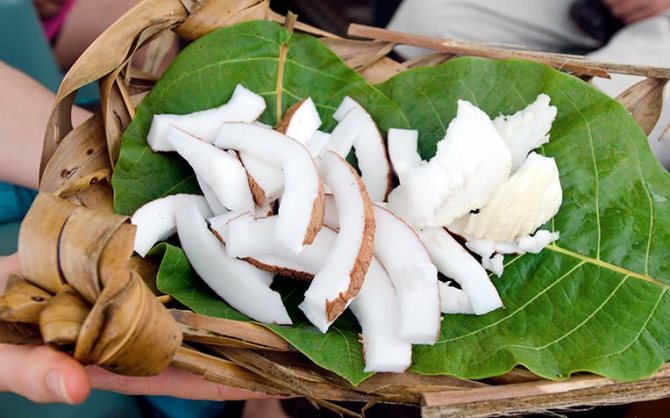

Watering
The basic rule of caring for a coconut tree at home is regular and abundant watering. Even the slightest drying out of the soil can lead to illness, or even the death of a tropical beauty. Therefore, make sure that the substrate is always moist. And water the palm tree as soon as the top layer dries up by 1-2 cm.At the same time, make sure that the water does not stagnate at the roots, because this can lead to their decay. Therefore, always drain excess water from the sump.
As a rule, you need to water the plant 3-4 times a week in the summer and once in the winter. But still, be guided by the conditions of your apartment. Use soft, settled and warm water for irrigation at any time of the year.


What is Uto?
This is what the Cook Islands Polynesians call sprouted coconuts. The inside of a sprouted coconut has a softer flesh, and when cooked over charcoal, it tastes like pudding. After cooking uto on charcoal, it is easier to crack the nut, and it is done in the same way as for mature coconut, without piercing the "eyes".
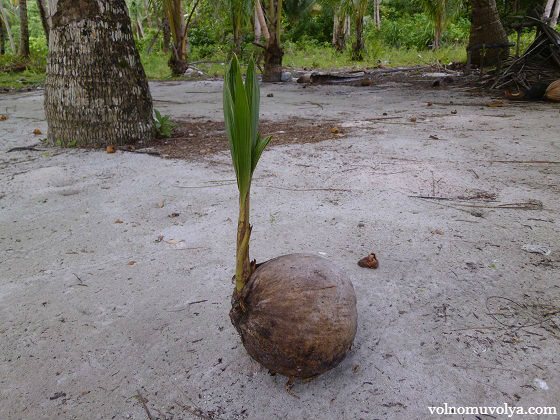

Coconut sprout, young palm


Coconut endosperm is initially liquid and transparent, in fact, this is coconut water - our longed-for liquid. Over the course of its maturation, droplets of oil secreted by copra enter the endosperm, and then this liquid turns into a solid core. At this time, a sprout is already visible from the outside.
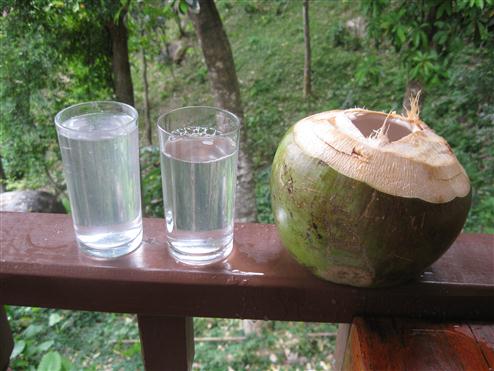

Coconut water from young coconut
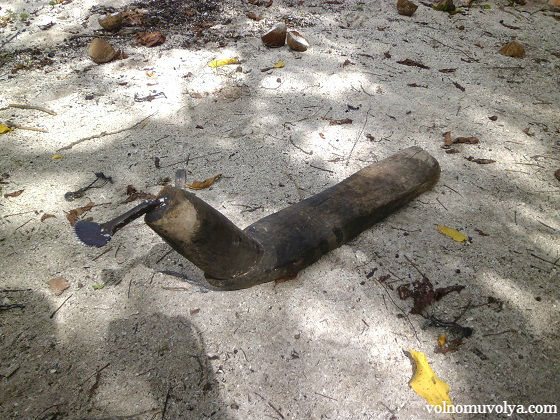

Kukur - a tool for rubbing copra
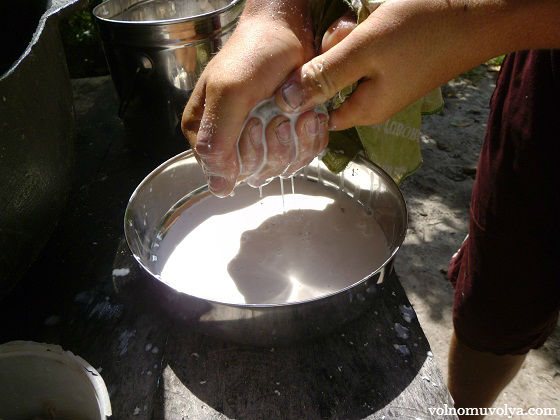

Pressing grated copra - coconut milk
Coconut milk is a grated copra squeeze product. Ripe copra is rubbed on a grater, then the resulting shavings are thoroughly squeezed out and milk is obtained. It can be made thinner by adding plain water or raw coconut water. Copra fatty concentrate (coconut sauce) can cause stomach upset if you are not used to. When added sugar, a very tasty product is obtained.
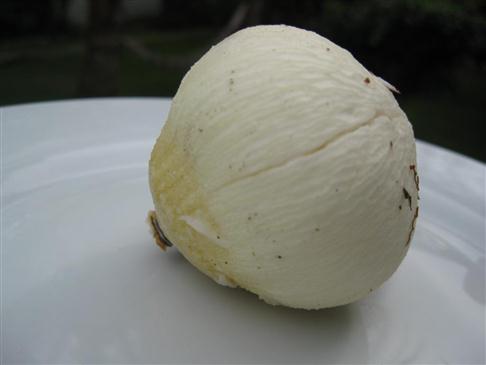

Sprouted fetus endosperm (Uto)
Photo gallery
Transfer
Often it is not necessary to transplant a coconut tree, because the plant responds extremely negatively to root trauma. Nevertheless, this procedure should be carried out every two years for young plants that have not yet been freed from the nut. It is enough to transplant adult specimens every 4-6 years. It is better to start the event in the spring, then the plant will more easily transfer the stress from the procedure. And in those years when the transplant is not carried out, be sure to replace the topsoil.


Prepare the substrate and a suitable pot before the event. For coconut, a fibrous, coarse and highly permeable soil mixture is suitable. If you wish, you can buy a special soil designed for palm trees. Or make the substrate yourself. To do this, mix the following components in equal parts:
- sand;
- peat;
- sod soil;
- clay;
- humus;
- agroperlite or expanded clay.
If you make the mixture yourself, be sure to disinfect it. To do this, pour the substrate into a baking sheet in a 5 cm layer. Then add a liter of water and stir the mixture well. Then preheat it in the oven for 1-1.5 hours at a temperature of 60 degrees.
As for the plant pot, choose containers whose diameter is 4-6 cm larger than the previous ones. But the palm tree does not have any special requirements for the material, so you can choose both clay and plastic flower pots.
From shell to kernel
|
Plucked coconuts, like all other parts of this extremely healthy palm, are used in their entirety: from shell to kernel. Europeans are used to seeing brown hairy balls in supermarkets, but coconuts on a palm tree look very different. The fruit is covered with a dense, smooth green shell, which may turn slightly yellow or red over time.This outer shell is called the exocarp by botany. Under it is a thick layer (2-15 cm) of brown fibers. This layer - the mesocarp - is scraped off along with the exocarp immediately after the coconuts are on the ground. Before we part forever with these two layers, peeling them off the fruit, note their extreme importance in the spread of the species, and see how this raw material is used. If the layer of fibers ensures the buoyancy of fruits that fall into the water and are carried away by the current, and protects the seed from overheating in the tropics, then the water-impermeable endocarp serves as a reliable capsule. In unripe young fruits, the mesocarp is edible. After the exocarp and mesocarp are removed, the fruit acquires the familiar round brown “nut” appearance overgrown with brown fibers. Note that the usual phrase "coconut" is incorrect from the point of view of botany. In fact, the fruit is a drupe.
|
The fibrous layer - coir or coir - is an important raw material, for the sake of which part of the crop is removed unripe. Coir is not subject to decay, and this property is invariable at any humidity and temperature, it perfectly retains its shape and serves for an exceptionally long time. This material is used in the furniture industry as an elite filler for mattresses and upholstered furniture; mats, ropes and rough fabrics are woven from it. The main producers of coir in the world are India and Sri Lanka.
The next coconut shell is endocarp - a very tough brown "nut shell" by which we can easily recognize coconuts on the shelves of grocery stores. The hard shell covers a single seed, which consists of an embryo and endosperm - solid and liquid. From the inside, the "shell" is covered with a layer of solid white endosperm 1-2 cm thick, and the inner cavity is filled with liquid endosperm. When we buy coconut in the store, we expect to get a sweetish refreshing juice (ie liquid endosperm) and a layer of white fatty solid endosperm lining the "shell" from the inside, which is familiar to us from coconut flakes, which are widely used in the confectionery industry. It is from this layer that valuable raw materials are obtained - copra. A thousand nuts produce about 200 kg of copra. The annual production of copra in the world is about 5 million tons. The Philippines and Indonesia are the leaders in this production.
|
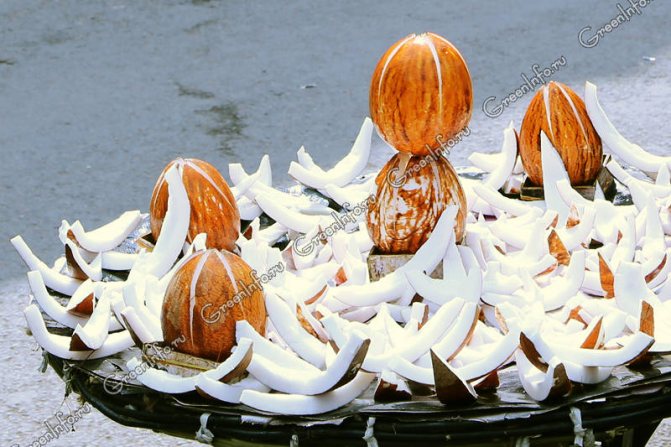

Before we get to the edible seed, let's look for an application for "shell". In industrial production, "nut shells" with fiber residues are crushed and a coconut substrate is obtained, which is used for growing plants. It has a high moisture capacity and air permeability, biologically pure and does not rot. These properties also make it possible to improve the composition of any soil when mixed with it. They sell coconut substrate in the form of briquettes: 5 kg of pressed substrate turns into 80 liters of full-fledged soil when soaked.
Endocarp has been used for making dishes for a long time. In Russia, they first learned about coconuts in the 17th century under Peter I, who brought from Europe a goblet of coconut shells. Since coconuts were considered an "Indian curiosity" in Europe, the price of this curiosity was imperial, as was its design. This can be confirmed by the exhibits of historical museums around the world.
| Coconut cups. XVII century Silver, gilding, chasing, coconut, carving |
At the base of the fruit, three "eyes" are clearly visible, which do not overgrow with fibers and make the fruit look like a monkey's face. These are pores formed in the place of three carpels. Three pores correspond to the location of three ovules, of which only one develops into a seed. The pore above the forming seed is easily permeable, it is through it that the sprout breaks out, while the other two are impenetrable.
|
Occasionally there are coconuts in which all three pores are impenetrable. In such "tightly corked" fruits, the embryo can turn into a unique "coconut pearl".A beautiful white, smooth and hard shell, reminiscent of mother-of-pearl, covers the embryo, turning it into a jewel. Coconut pearls are considered the only gemstone in the world of plant origin. So everyone who opens a coconut has a chance to find this miracle of nature in it - pearls, much rarer than sea pearls. True, the likelihood of such luck is extremely small and is approximately 1 chance per 7500 fruits. One of the famous coconut pearls is exhibited at Fairchild Botanical Garden (Miami, USA). Like any unique gem, she has a proper name - "Maharaja".
Description of coconut
Where the coconut grows, the fruit looks a little different than people see it on the shelves of the sales area. Under natural conditions, the nut is much larger.
The outer fibrous shell (exocarp) of the walnut protects it if it falls. The inner shell (endocarp) is a shell with 3 eye-like pores. They lead to three ovules, one of which develops into a seed, consisting of a superficial fleshy white layer (12 mm thick) and endosperm (transparent and liquid - coconut water). The oil that appears in it, released by copra, slowly turns into a milky emulsion, and then, thickening, solidifies.


Spread
People contribute to the spread of this plant. The main way is across the ocean. The fruit of the coconut is impervious to water, it is located on the surface of the water surface and is carried by the current to the rest of the continents. The walnut, while alive in the ocean, can swim for more than 3 months. By ocean currents, the fruits are carried over a distance of more than 6,000 km.
The walnut's line is determined by the main ocean currents. Coconut, which grows on the coast of India, is carried by the current of the Kuroshio to the north. If the fruits are not picked up by Kuroshio, they are transported by the North Pacific Current, which carries them to the coast of California. So, this plant can spread almost throughout the entire globe.
Gallery: coconut tree (25 photos)
Growing conditions
Where does the coconut grow? A photo with views of the sea coast often has this beautiful exotic tree as its main element. This plant can be found in nature along the coasts of the ocean and seas, and on the plains, but mainly with sandy soil.
This growth is associated with the fact that the only possible natural way of moving coconuts is along the surface of the water. Moving to distant shores, coconuts, which have excellent waterproof properties, began to successfully conquer new territories. Palm trees growing far from the coast are the result of human activity.


Where do coconuts grow?


Coconut grows naturally on the ocean coast. The areola of growth of representatives of various species covers almost all tropical regions. Palm plantations have been in Indonesia, Africa, the Philippine Islands, and Malaysia for a long time.
Indonesia is the main supplier of nuts. In Europe, palm trees are found in Spain, but not directly on the mainland, but only on the Canary Islands, located in Morocco on the African continent.
In nature, the tree grows on the sandy soil of the coastal part of the ocean. The root system can take root in salty soil, so the plant thrives on the seashore when other tree species cannot germinate.
The only breeding option is by seeds. Foliage is formed from the fruit. Taking into account the development of the tree, the lower leaves crumble, new ones grow from the growth ovule. Thus, the palm tree stretches out, forming a powerful cicatricial trunk.
How to choose a planting nut
We can only guess what the coconut looks like inside. When choosing a nut in a store, you need to follow these recommendations:
- You need to weigh the nut, it must be heavy, despite its small size.
- You need to shake the fruit: with a dull gurgling liquid inside, it will be ripe, with a ringing sound, there will be little milk in it. This means that it has almost dried up, and there will be no tasty and juicy pulp to feed the sprout. If the pulp knocks inside, it means that it also dries out or deteriorates.
- You need to smell the fruit: in the absence of the legendary coconut smell, in addition to the light aroma of the fibrous coating, you can safely purchase it. A pungent characteristic smell will immediately indicate a spoiled nut. It cannot be purchased, since it is possible to grow a coconut palm at home only from a “live” fruit.
- It is required to find three small, dense, dry and darker than the shell holes in the place where the nut is attached to the palm tree, from which the roots will go.
- It is impossible to determine what coconut milk looks like in a whole and healthy nut. But, if, with careful pressure, a fountain of fermented milk appears on each hole, then you have pushed through the already rotten shell. A whitish coating on the holes indicates a nut that is spoiled inside. On a normal and ripe nut, it is impossible to press holes with a finger.
- The fruit shell should be free of cracks, deep chips, dark wet spots, whitish or pinkish areas.


Origin history
Where does the coconut grow? The story goes that, according to some sources, the coconut palm originated in the Malaysian archipelago. Fossilized fruits have been found in New Zealand. It is also known that palm trees have been growing in India for 4000 years. Therefore, many scientists believe that this type of palm originated precisely on the shores of the Indian Ocean.
So, perhaps the origin of the coconut is Southeast Asia, Polynesia, India, the Pacific Islands, Hawaii, South Florida, the Caribbean and Southern California.
In fact, the tree is the most common and necessary in the tropics, and practically is the "tree of life". And this is true, because all parts of it are used in people's lives.
The coconut palm is one of the most ancient trees on the entire globe, growing even in the era of the dinosaurs.
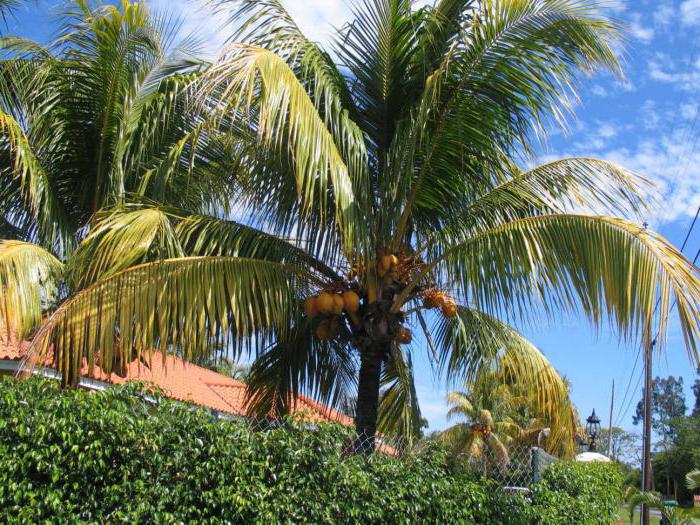

Pruning
Formative pruning is not done for the coconut tree, but the tree still needs to be cleaned periodically. Otherwise, the plant will lose its decorative appearance, moreover, it will develop poorly. Therefore, remember to cut off dried and damaged leaves. But remember that you can only remove completely dead fronds, and it is better to leave the ones that have slightly changed their shade and are half dried on the tree. After all, the palm tree draws out additional nutrients from them.
During pruning, do not damage the trunk in any way, and even more so do not touch the apical bud of the plant. Otherwise, the palm tree will die. Also, never remove more leaves than have grown in a year.
How to replant a palm tree
The coconut tree reacts very negatively even to touching its roots, not to mention injuries. Therefore, a tropical plant should be transplanted carefully and exclusively by the transshipment method. To do this, follow the following algorithm:
- Place a 3 cm layer of drainage at the bottom of the planting pot. For these purposes, use broken brick, pebbles or expanded clay. Powder the drain with a 1-inch layer of soil.
- Carefully remove the plant from the old pot and place it in a new container along with the earthy clod.
- Fill the voids with soil and lightly compact the substrate. To do this, gently knock on the sides of the pot. Make sure that half of the nut remains on the surface of the soil as before. If the palm tree has already dropped the fruit, then do not leave the same depth level. That is, do not completely cover the roots, some of their length should remain on the surface.
- Water the soil and place the palm tree in its usual place.
Copra
Coconut water is the inside of the endosperm, and the outside is copra.The second is a source of coconut oil, which is quite a valuable product due to the content of various fatty acids in it. It is mainly used for health and beauty purposes.
It is an oily dried secondary endosperm of nuts. Copra consists of white or yellowish pieces covered with skin. Their thickness is 6-12 mm. One nut gives up to 500 grams of copra, which is an edible product containing 9% protein, 6% water, 16% carbohydrates and 67% fat.
Where coconut grows, copra harvesting at one time was almost the main occupation of the inhabitants of the islands in the tropics. The atolls (where there were few palms) were specially planted with coconut palms. Copra is a valuable commercial product that has long been traded in the southern seas. And today they are preparing it.
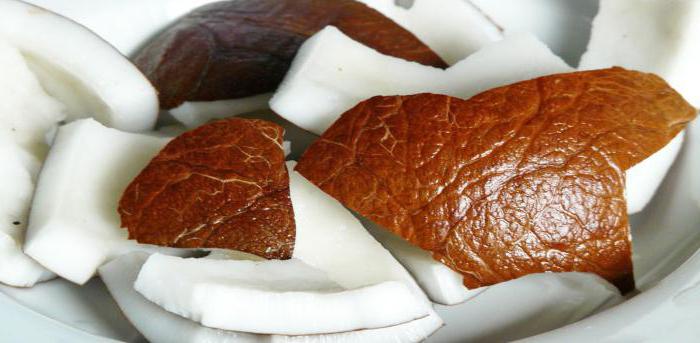

Filipinos are considered to be the biggest copra miners. Both large companies and farmers procure it.
It is worth noting that if copra is not dried properly, molds can form on it, producing a deadly poison (Aflatoxin). This most potent carcinogen can cause liver disease. Copra should not be eaten, but it is sold. Oil is obtained from it, and it, obtained industrially, is harmless.
Growing places
Where do coconuts grow, in which country? This exotic fruit today exists both in the wild and in culture in the Philippines, Africa, Sri Lanka, South America, India, Brazil, Thailand and the Antilles. All these countries have a rather hot tropical climate.
They are cultivated mainly in developing countries. The annual production of coconuts is amazing. Approximately 17 billion nuts are harvested annually where coconuts grow. The country of the Philippines is the world's leading manufacturer. Besides her - Indonesia, Malaysia and India.
This fruit is the most famous of the huge Palm family (about 1500). There are over 360 ways to use it, with half of them related to cooking.
This plant is exclusively equatorial. Widespread distribution is associated with the attitude of a person to this plant (the use of nuts, artificial planting).
Application
For construction, wood and palm leaves are widely used, and fruits are used for food. However, it should be noted that for many people this palm tree may turn out to be the tree of death, since a blow from a coconut that falls on the head can even lead to death. According to existing statistics, about 150 people die from the fall of these fruits every year. On average, the weight of a coconut is about 1 kilogram (there are also 3 kilograms), and it hits the ground with a force of 1 ton. To a greater extent, the inhabitants of those countries where coconut grows have excellent natural material.
Ocean, islands, palm trees
What can you do here, humanity is subject to certain stereotypes. What will most of us think of when we hear the word "tropics"? Well, yes, turquoise sea-ocean, blue silk sky and of course palm trees. Palm trees bent almost over the surf, slender symbols of tropical islands ... The inhabitants of the oceanic islands call them the tree of life and the tree of a thousand useful things. The tree of Life? Something familiar .. well, yes, the date palm was already called the tree of life, but only it grows in a completely different region, also hot, but extremely arid (see Date palm - the tree of life) Well, it is quite possible - in each edge has its own cherished trees. In the oceanic expanses of the tropical belt, the tree of life is also called a palm tree, but a coconut tree.
The coconut palm (Cocos nucifera) belongs to the numerous palm family of the Arecaceae, where it is separated into a separate genus Cocos, to which there is not a single plant besides it. It seems that nature itself has noted the uniqueness of the tree, which plays such a significant role in the lives of people living on islands in the ocean.
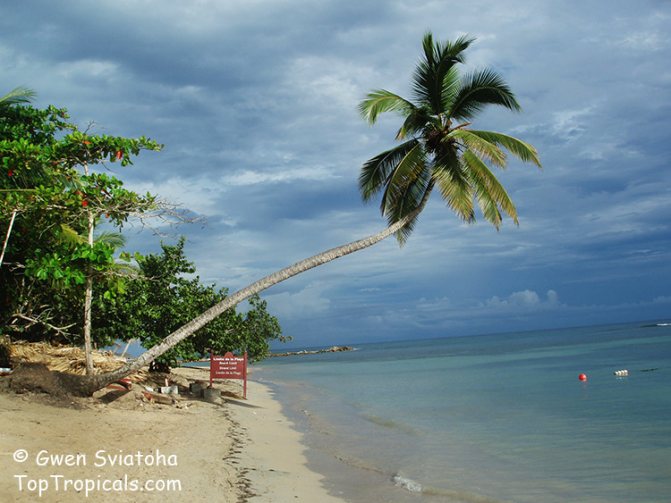

The original homeland of the coconut palm is Oceania, from where it began its conquest of the world. The ocean played a huge role in the widespread prevalence of the coconut palm. This was facilitated by the sailors, who gladly included the fruits of the palm tree in their provisions and thus transported them across the seas and oceans, from island to island, from one port to another. However, in addition to the intervention of the human factor, it should be taken into account that the fruits of coconuts are very light, they have excellent buoyancy and are able to overcome huge distances, drifting along with the sea currents. What's more, coconuts have amazing vitality. There were cases when even those brought far to the north, to the shores of Norway, some fruits did not lose their germination. Currently, in nature, the coconut palm grows on the islands and coasts of the continents between 26 degrees north latitude to 26 degrees south latitude - with the exception of perhaps the interior continental territories of South Africa and South America.
In the tropical belt, the coconut tree can be seen everywhere. It grows in the wild and is specially developed as an ornamental plant. Since time immemorial, almost all parts of this plant have found their use in people for culinary, medical and other, very diverse purposes.
The phenomenon of the coconut tree could not but be reflected in the beliefs and myths of various peoples. In the Philippines, people are said to have descended from two coconuts carried by the sea to a rocky shore. From one of them came Lalaqui - men, and from the other - Baye (women). According to another legend, typical for many peoples of Polynesia, coconuts germinate only where they can hear the sounds of the sea and human voices. These poetic images clearly indicate that people believed that the spread of the coconut tree was inextricably linked with the sea and people.
In Europe, they first learned about the coconut tree from the description of the Italian traveler Marco Polo, made in 1280. He gave its fruit the name nux indica, which in Latin means "Indian nut". It was the Indian nut in Arabic and in Hindi that the inhabitants of the island of Sumatra called coconuts, where the great Italian got acquainted with this plant. The name Cocos appeared after the voyages around the world of the Portuguese navigator Vasco da Gama. The sailors claimed that the name Coco belongs to a witch from distant islands, whose face was imprinted on a hairy nut. However, according to another version, coco is just the name of local monkeys, whose funny faces resembled coconuts. One way or another, the name stuck and became part of the scientific name of the plant. The second part, nucifera, means "nutty"
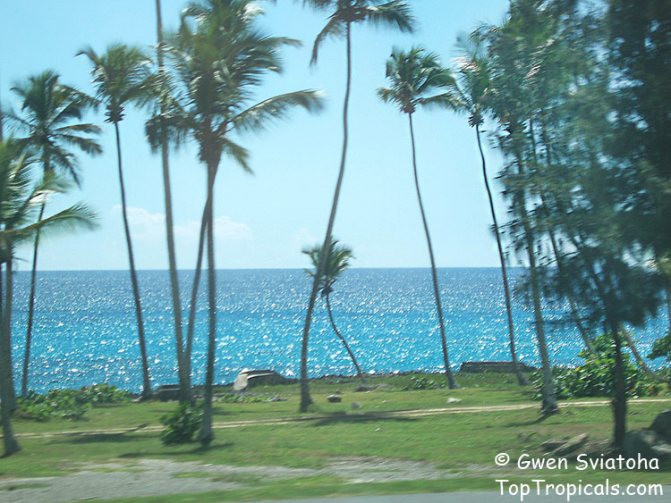

Tall, low, slender
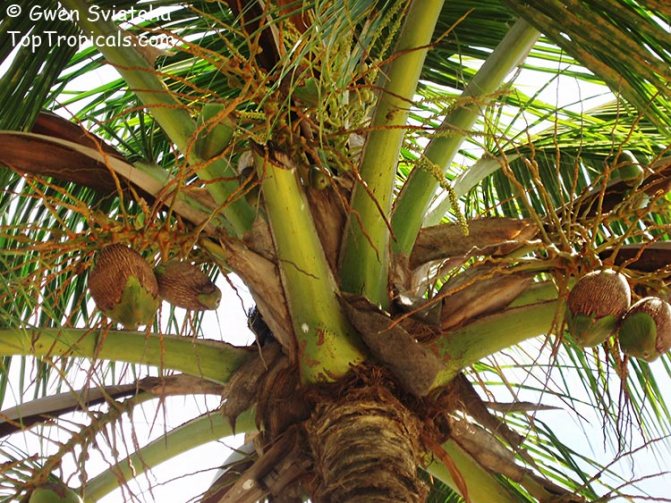

The tree also shows incompletely opened inflorescences and ripe fruits
Cocos nucifera is a tall, slender palm with large, five-meter feathery leaves; the length of the "feathers" of the leaf can be up to a meter. When old leaves die off, the trunk of the palm tree remains flat and smooth.
In general, coconut palms are classified into two main classes: tall and dwarf. For commercial use, mainly tall palms are planted. They grow more slowly and live for about seventy years. Their first flowering occurs only in the sixth or seventh year of life. The height of an adult plant is 15-20 meters, the fruits are medium and large in size. The most popular varieties of tall coconut trees are Ceylon Tall, Indian Tall, Malayan Tall, Jamaica Tall, Java Tall and Laguna - the latter is especially loved. in the Philippines.
The height of dwarf coconut palms (Cocos nucifera dwarf) is about ten meters, but these palms begin to bloom as early as the third year of life, when their height barely overcomes the meter mark.The life cycle of these trees is no more than thirty years. Although the cultivation of dwarf coconut trees is more labor intensive, these trees are quite common and are considered valuable because of their early fruiting and resistance to disease. Among the dwarf palms are Malayan Dwarf, Dwarf Green and Dwarf Orange.
The flowers of the coconut tree form inflorescences in which both male and female flowers are present. Flowering occurs constantly throughout the year. Coconuts are pollinated by wind and insects: bees, wasps, ants, weevils, and dwarf species Cocos nucifera dwarf are capable of self-pollinating. After pollination, fruits are formed on the palm, which are usually called coconuts, although in the strict botanical sense they are not nuts, but are drupes. One tree can produce up to 75 fruits per year.
What are these amazing non-walnuts? Let's take a closer look:
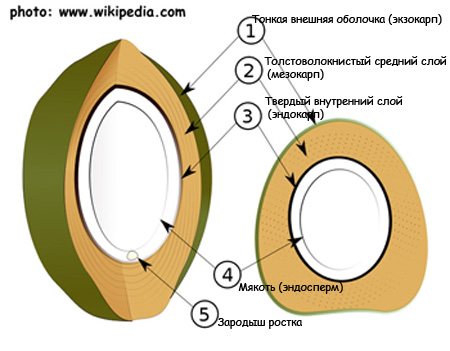

The upper shell, exocarp, covering young fruits is thin; at first it is green, then it becomes yellowish and, finally, the nut begins to gradually shed it. From the golden yellow exocarp, like a snake changing its skin, a dense, thick-fibred middle layer-mesocarp appears. It is he who gives the coconut fruits the usual "hairiness". On the inside, the mesocarp is separated from the fruit pulp by a thin, but hard, inner layer-endocarp, and already in the very middle, there is endosperm - this is what, as the fruit ripens, is first called coconut water, then - coconut pulp and, finally, copra ... At the base of the endocarp is the embryo - the embryo of the future sprout.
Outside, three dimples are clearly visible on the coconut; each pore represents one of the three carpels of the plant, but only one of them has a functional significance: through it, during germination, the sprout leaves the endocarp. This time is through, through it you can easily get inside the nut, for example, by inserting a regular paper clip inside. The other two pores are impenetrable blind depressions. Very rarely, all three pores of a coconut turn out to be "blind", non-functional. Such a fruit cannot sprout, however, they are the alleged source of coconut pearls - this is the name of the embryo, which, being in such an unnatural situation, is covered with a beautiful white, smooth, hard shell.
The mechanism by which coconut pearls originate remains unclear. It is considered the only gemstone in the world of botanical origin. It can be found very rarely, it is formed in about one of seven and a half thousand fruits and is usually found by accident, when a coconut is opened in the kitchen.
One of the most famous coconut pearls, named "Maharajah", is on display in Fairchild Botanical Garden (Miami, USA). Do you want to walk through this botanical garden? Then you are here.
Photo taken by musician Richard Shaw Brown shows a 1-inch (2.5 cm) pearl he found.
Water, milk, oil
The clear liquid inside an unripe coconut is called coconut water, although in essence it looks more like a thin gel. For centuries, coconut water has been a favorite drink, widespread in the tropics: in Southeast Asia, the Pacific Islands, Hawaii and the Caribbean, Florida and the countries of South and Central America. This refreshing and toning liquid is, moreover, very low in calories - only 16.7 calories per 100 grams. It contains sugar, vegetable fibers, protein, vitamins and minerals, has pronounced antioxidant properties. In its composition and other indicators, coconut water is close to blood serum, it is a kind of natural saline solution.
These qualities make coconut water not only a pleasant thirst quencher in the humid tropics, it is also used as a sports tonic. In addition, until the coconut is opened, the coconut water is absolutely sterile, it can easily mix with human blood. These properties during the Second World War made it possible, in the absence of donor blood, to use it as a blood substitute for urgent transfusion. Continuous use increases lactation in lactating women, and also helps dissolve kidney stones - among the islanders you can still hear the term "water therapy" today. In this case, it is precisely the treatment with coconut water that is meant.
They learned to preserve coconut water; today it is sold packaged in glass bottles and cans. It is used to make a jelly-like dessert called nata de coco. But in the hot tropical summer, what could be better than a fresh young coconut, from which the top was cut and the tube inserted? Mm-mmm .. unique!
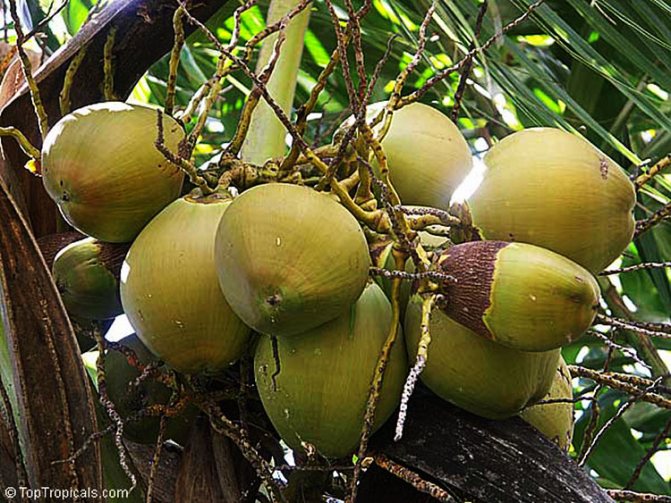

Coconut milk is a sweet, milky white, creamy substance derived from the pulp of a ripe coconut. Rich in flavor nuances, the taste provides milk with a high content of butter and sugars. Unlike coconut water, which is the natural liquid found in unripe fruits, coconut milk is made, so to speak.
There are two types of coconut milk: thick and thin. Thick milk is prepared by directly squeezing the coconut pulp through cheesecloth. Then the squeezed pulp is dipped in warm water and squeezed a second or even a third time, getting thinner coconut milk. Thick milk is used mainly in desserts and cold sauces. Liquid milk is added to soups and is widely used in general cooking, especially in Southeast Asia and the Philippines. However, in Western countries such subtle nuances are absent: fresh coconut milk is not produced there, and most people buy canned coconut milk in cans. Milk makers typically combine thick and liquid milk using water as a diluent.
An open can with unused milk can be stored in the refrigerator for no more than two to three days, then it turns sour and becomes unusable.
You can make coconut milk yourself at home. The dried, already fairly firm pulp of a coconut purchased from a store is grated and poured with hot water or milk, which helps to extract the oil and aromatic compounds present in the fruits of Cocos nucifera. The coconut oil content is about 17% of the total weight. After the mixture has cooled and settled for a while, a natural separation occurs: thicker and fattier coconut cream rises to the surface, and liquid milk stays at the bottom. Done correctly, the cooked milk leaves almost no coconut smell.
Coconut milk can be drunk fresh, as a standalone drink, or added to tea, coffee, cereals, etc. Fresh coconut milk is reminiscent of cow milk in its consistency and soft, slightly sweet taste. In temperate latitudes, it is most often used by especially strict vegetarians (vegans) or people who are allergic to animal milk. It is mixed with various fruits and berries and eaten instead of yoghurts, together with coconut flakes, it is widely used in baking confectionery.
When the coconut cream has cooled and settled, it is collected and by reheating and separating the fatty fraction, the best coconut oil is obtained. The oil obtained in this way is considered an order of magnitude more valuable than that obtained from copra - the dried pulp of a ripe coconut. The remainder of the production of coconut milk is used to feed livestock.


Palm wine, millionaire salad and more


Coconuts growing on the beach of Fort Myers (Florida)
In addition to fruits, the inflorescences of the coconut palm are also eaten. From the fermented juice of the inflorescences, palm wine is obtained - toddy, and fresh, unfermented juice is usually drunk twice a day, for breakfast and lunch. By boiling over low heat, a syrup is obtained from the juice, from which, after adding coconut flakes and a drop of toddy, candy is made. Coconut nectar, squeezed out of unopened buds, is drunk in the morning as an "elixir of life" - such an energizer allows the islanders to live up to 85-90 years of age, while remaining healthy and vigorous.
The apical bud, also called the heart of the palm, is also edible. It is considered a rare and very expensive delicacy, as cutting it usually kills the tree. These buds are used to make a salad, which is called "Millionaire's Salad" - it's understandable why: after all, several servings of such a salad cost the life of one slender, beautiful palm tree.
Young sprouts of a coconut tree are covered with edible down, which tastes and consistency resembles marshmallows. It is the food that the endosperm feeds the developing newborn plant early in its life.
People use the coconut tree almost entirely. Dyes are made from the roots, their split pieces are used instead of toothbrushes. The solid and plastic wood of the trunks is used for the construction of small bridges, benches, tables, picture frames are made of it, figures are carved, bungalows and houses for keeping pets and poultry are built. Boats are made from solid trunks.
And why not weave from coconut leaves: roofing for roofs and mats, hats and lampshades, trays and napkins for cutlery, baskets and bags. The hard midribs of the huge leaves are burned, and glue is made from the remaining ash.
Coconut fiber covering the surface of a mature coconut is used to make ropes, mats, brushes, sacks, and compost mixture for garden and pot plants. Fiber is used as fuel and charcoal is obtained from it.
In the 80s of the twentieth century, a special method was developed for separating coconut fiber from the main part of the shell, which greatly simplified its production. In the Philippines, dried hairy coconut halves are used to clean and polish wooden floors and parquet floors. Beads and bracelets are made from dried mesocarp, cleaned of fiber, which are readily sold by tourists.
The coconut has also found application in art: in Asian countries, dried halves are used to create theatrical noise effects, for example, when imitating the clatter of horse hooves. In China and Vietnam, they are used to make cases of ancient folk musical instruments.


In the leaves of a coconut tree, birds hide from the rays of the scorching sun
Most most..
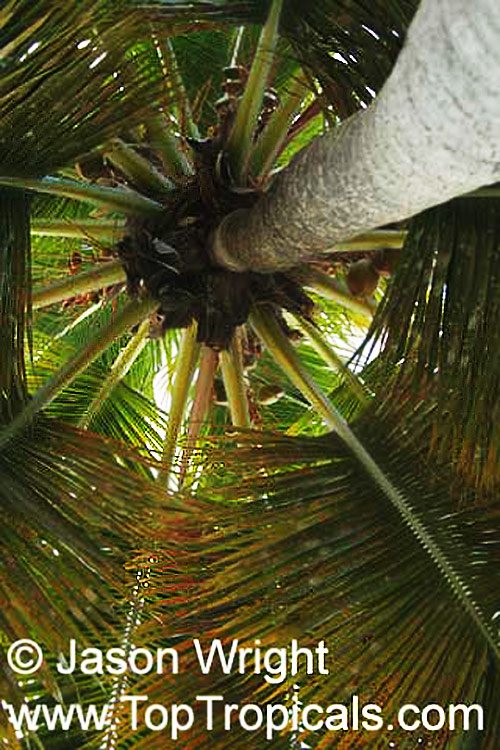

People living in different parts of the world, belonging to different races and religions, speaking different languages, agree on one thing - in their attitude to coconuts, highly appreciating their culinary properties and even more - healing. Wherever coconut trees grow, traditional medicine effectively uses their fruits for a wide variety of medical purposes, considering it a universal medicine that heals thousands of diseases.
Modern medical science has confirmed the indisputable importance of coconut water, milk and especially oil in the prevention and treatment of a wide range of diseases, including cancer, AIDS, hepatitis and other liver diseases, diabetes, cardiovascular disorders, skin diseases .. The full list would take at least at least a couple of pages.
Coconut oil is recognized by scientists as the most beneficial oil in the world. It can be consumed by people even with the strictest diets.It is widely used in cosmetology: it is included in creams and lotions, shampoos and hair masks, soaps, and even - as an exotic perfume - in the preparation of perfume compositions.
Of course, a coconut tree is not suitable for breeding at home, unless you live on an island located in a paradise in the middle of a warm ocean, or at least in Miami. It is believed that for the survival of this inhabitant of the tropics, at least four minimum conditions must be met:
- no frost for at least 50 years;
- the minimum night temperature is not lower than + 12-13C;
- the annual amount of precipitation is at least 1000 mm;
- the absence of trees with a lush crown in the neighborhood, so that the flamboyant neighbors do not obscure the sun's rays for this tropican.
And the ten-meter height of even a dwarf palm tree does not add optimism.
But is it worth getting upset? The main thing is that we met her! Arriving at the store and looking at the strange hairy "balls" lying on the fruit and vegetable counters, we nod affably: "Hello, Coco!" After all, now we know how many good things are hidden under their unusual shell. Or maybe we will have the courage to try to cook something exotic, tasty and healthy with their help? Weak? !!
Features of transplanting and pruning a plant
When you figured out how to plant a coconut, you need to monitor its growth and replant on time. The most suitable period for this is April. Palm trees are transplanted annually, using containers 10-15% more than the previous ones.
In the process of planting a plant, part of the roots, which are responsible for the formation of the felt layer, must be cut with a knife so that the plant fits into the pot without any problems. The old earthy clod remains on the roots.
The transplant depth should not change. If the trunk has been damaged, immediately treat it with garden varnish. If the apical buds of the plant are damaged, then it will soon die.
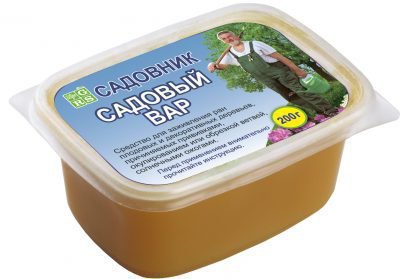

If the trunk is damaged, it is urgent to treat it with garden varnish.
Temperature
The coconut palm is one of the most thermophilic plants. And all year round, near the flower pot, it is advisable to maintain the temperature within + 21 ... +23 ° C. In summer, the culture will survive even more sweltering heat. But in winter, a strong drop in temperature should not be allowed. Of course, the palm tree will survive a short-term cold snap to + 16 ... +19 ° C. But it is better not to bring it to this, otherwise you risk losing it.
Despite the love of heat, the coconut tree absolutely cannot stand stagnant air. Therefore, the room where you grow the tropical plant should be regularly ventilated. But carry out these procedures very carefully, because the culture has a negative attitude towards a draft and a sharp drop in temperature. Therefore, take out the palm tree during airing to another room, if possible.
To get the harvest sooner
The coconut tree begins to bear fruit at the age of 6 years, gradually increasing its yield to a maximum by 15 years and reducing it only after 50-60 years due to the aging of the tree. An adult tree gives an average of about 100 fruits per year, under favorable conditions, the yield can be increased to 200 fruits per tree.
|
As a result of long-term cultivation of the coconut palm, a large number of varieties have been created, which are divided into 2 groups: vigorous (ordinary) and undersized (dwarf). They differ significantly in biological and production characteristics.
The bred dwarf varieties have a shorter productive period - 30-40 years, but the first fruits appear on them in the 4th year of life, when the tree has only 1 meter of growth. By the age of 10, the coconut tree is capable of producing the maximum yield. The fruits of dwarf palms are smaller than those of vigorous ones, but it is much easier to harvest from a maximum height of 10 m than from trees with a height of 20-25 m.
Fruits of vigorous varieties are round, almost spherical, about 30-40 cm in diameter and weighing up to 3 kg. Falling from a height of 20 m, they acquire a terrible destructive force. Harvesting is carried out all year round with a frequency of 2 months. An experienced picker can collect up to 1,500 nuts a day, for this he needs to masterfully wield a long pole with a knife at the end. Less productive is the method of harvesting with climbing palm trees to a height of 20 m. On the plantations of about. Samui (Thailand), where the supply of coconuts reaches 40 thousand pieces per year, began to be used for harvesting trained monkeys, each of which is able to collect twice as many nuts as a person, due to the speed of climbing. Collecting coconuts by monkeys has become a tourist attraction, which gives additional profit to the plantations.
How the coconut tree spreads across the oceanic islands
The spread of the cultivated coconut palm is facilitated by humans. The main way of spreading wild trees is water. The coconut fruit is waterproof, falling into the ocean, it stays on the surface of the water and is carried by the ocean current to other continents and islands throughout Oceania. The fruit, remaining alive in salt water, is able to travel for more than 100 days. By sea currents, coconuts are from their native shore at a distance of up to 5 thousand kilometers.
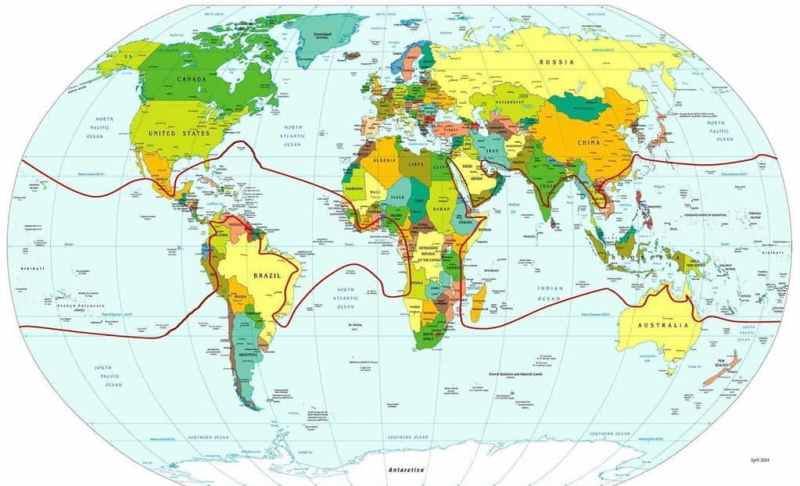

Coconut natural distribution map
Coconuts are waterproof and float freely in the water, carried far away by ocean currents, while maintaining their vitality.
The line of the route of movement of the fruit of the coconut palm is determined by the main currents of the sea. Coconut, grown on the coast of Indonesia, belongs to the warm Kuroshio Current to the north and settles along the coast. If the nuts are not carried ashore by the Kuroshio Current, they are picked up by the warm North Pacific Current, which transports them to the California shores of North America. Thus, this amazing traveler plant spreads around the world.

